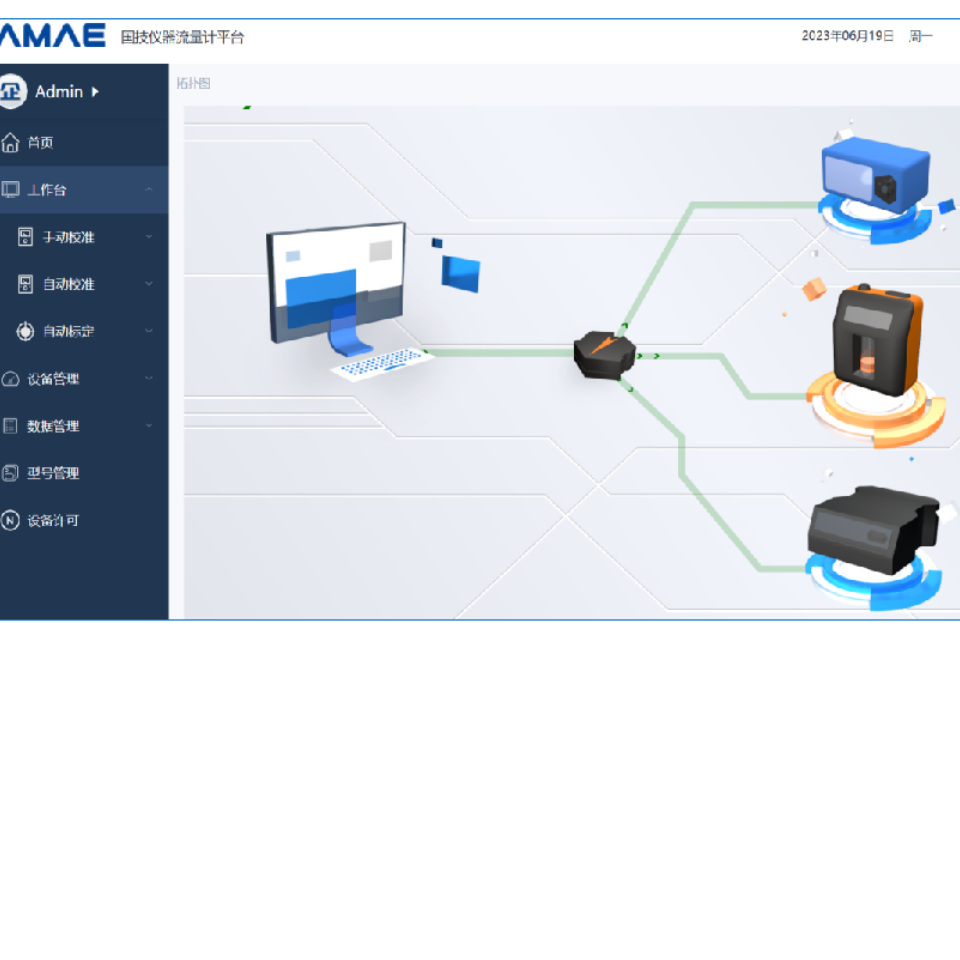采用LaVision公司最短帧间时间间隔可达115纳秒的跨帧相机,可以测量的速度上线可达十几公里/秒。本文的测试速度就达到了5倍音速。
方案详情

Sensors 2014, 14,23462-23489; doi:10.3390/s141223462 23463Sensors 2014, 14 ISSN 1424-8220 www.mdpi.com/journal/sensors Article Penetration Characteristics of Air, Carbon Dioxide and HeliumTransverse Sonic Jets in Mach 5 Cross Flow Erinc Erdem 1, Konstantinos Kontis 1,* and Selvaraj Saravanan 2 Aerospace Sciences Division, School of Engineering, University of Glasgow, Glasgow G12 8QQ,UK;E-Mail: erincerdem@gmail.com Department of Aerospace Eng'rg, Indian Institute of Science, Bangalore 560012, India;E-Mail: saravan@aero.iisc.ernet.in * Author to whom correspondence should be addressed; E-Mail: Kostas.Kontis@glasgow.ac.uk;Tel.: +44-141-330-4337. External Editor: Gerhard Lindner Received: 16 April 2014; in revised form: 11 September 2014 /Accepted: 10 November 2014/Published: 8 December 2014 Abstract: An experimental investigation of sonic air, CO2 and Helium transverse jets inMach 5 cross flow was carried out over a flat plate. The jet to freestream momentum fluxratio, J, was kept the same for all gases. The unsteady flow topology was examined usinghigh speed schlieren visualisation and PIV. Schlieren visualisation provided informationregarding oscillating jet shear layer structures and bow shock, Mach disc and barrel shocks.Two-component PIV measurements at the centreline, provided information regarding jetpenetration trajectories. lBarrel shocks and Mach disc forming the jet boundary werevisualised/quantified also jet penetration boundaries were determined. Even though J iskept the same for all gases, the penetration patterns were found to be remarkably differentboth at the nearfield and the farfield. Air and CO2jet resulted similar nearfield and farfieldpenetration pattern whereas Helium jet spread minimal in the nearfield. Keywords:: Flowsand jets through nozzles; velocity measurements; visualizationand imaging 1.Introduction Transverse jet injection into supersonic/hypersonic crossflows has been encountered in manyengineering applications ranging from scramjet combustors and solid rocket motor or liquid enginethrust vector control systems to high speed flying vehicle reaction control jets.The interaction ofthe transverse jet with the high speed cross flow creates complex three dimensional flow patternscommonly including separated regions, shock waves, shear layers and wakes, etc.The resultantflowfield has received significant interest since the 1960’s. Earlier studies were focused on wind tunnelexperiments utilising conventional measurement techniques such as schlieren/shadowgraph photography,wall pressure and concentration measurements to gain a better understanding of the jet interaction andpenetration phenomena [1-6]. These studies aimed to assess the effect of injection pressure ratio, thelocation of injection, the state of the incoming boundary layer and type of injectant gas on jets insupersonic/hypersonic cross flow phenomena. On the other hand several studies investigated mixing performance and penetration characteristicsof transverse jets in high speed cross flows at relatively low supersonic Mach numbers in “cold”wind tunnels [7-9]. These studies provided valuable experimental data shedding light on thejet penetration and associated trajectories measured by Mie/Rayleigh scattering. Specifically,Ben-Yakar [10] investigated the convection and mixing characteristics of hydrogen and ethylenetransverse jets at Mach 3.4 in an expansion tube with realistic upstream conditions for scramjetapplications. Ultra high speed schlieren photography and Planar Laser Induced Fluorescence (PLIF)of OH radicals were utilised to obtain detailed information on the molecular mixing. The mechanismbehind the mixing was found to be the promotion of small scale structures rather than globalmanipulations of the main stream since mixing leading to chemical reactions occurs at the molecularlevel. The near field mixing of transverse jets is dominated by so-called“entrainment-stretching-mixingprocess”[10], driven by large scale jet shear layer vortices as they are shown in Figure 1 (top figure).Due to the obstruction introduced by transverse jet, a bow shock forms and stands off from the injectororifice. In the region between the bow shock and the transverse jet, the injectant fluid moves witha higher velocity tangentially to the interface than the free stream fluid. As a result, large vorticesare periodically formed engulfing large quantities of free stream fluid and drawing it into the jet shearlayer (macro-mixing). These vortices are convected downstream at high speeds, where the injectantand air are then mixed by slow molecular diffusion. They stem from so-called Kelvin-Helmholtzinstabilities [11]. In general, large scale structures are beneficial for the enhancement of bulk mixing, butthey hinder fine scale or molecular mixing. However, they also stretch the interface between unmixedfluids. Stretching increases the interfacial area and simultaneously steepens the local concentrationgradients along the entire surface while enhancing the diffusive micro mixing [10]. In terms of othercoherent structures, horseshoe vortices formed by the upstream separated regions due to the adversepressure gradient caused by the bow shock, wrap around the jet periphery and convect downstream asthey are shown in Figure 1 (bottom figure). Counter rotating vortices develop on top of the normalshock (Mach disc) that is caused by sudden expansion of the jet stream. These counter rotating crossflow vortices are assessed by [12] as the primary source of entrainment of surrounding incoming flow airinto jet flow that is important for farfield mixing. They are produced by folding of the vortex ring, which is the downstream manifestation of vorticity arising from the sidewall boundary layers of injectors [13].Finally, wake vortices periodically shed near the base of the inner jet core and trail downstream underthe jet plume [12,14]. Figure 1. Top: mixing features of an underexpanded transverse injection into a supersoniccross flow; bottom: three dimensional perspective of the averaged features of the flowfieldby [10]. REGION Gruber et al. [7] shed light on the mixing characteristics of CO2 and Helium transverse jets in Mach 2cross flow with different injector configurations. Planar Mie scattering images provided global flowfieldcharacteristics, transverse and lateral penetrations for each injector configuration. Instantaneous andtime-averaged information concerning the structural organization of the flowfields was obtained. Ina similar study by Gruber et al. [8] in which air and Helium jets were utilised, it is suggested thatinjectant molecular weight variations did not strongly affect the penetration of transverse jet into the crossflow, athough they led to substantially different compressibility levels that dramatically influencethe characteristics of the large-scale structures formed in the shear layer and the entrainment andmixing occurring between the injectant and crossflow fluids. Results also indicated that air jet (lowcompressibility, based on convective Mach number) contained a larger mixing zone than Helium jet(high compressibility). The relevant parameter of jet penetration is momentum flux ratio, J, which isdefined below in Equation(1). Recently Schetz and Burger [15] investigated the effect of molecularweight on the transverse injection flowfield with Helium, air, methane injection and yet they found outthat the effect of molecular weight is weak. where y is the specific heat ratio, p is the density, M is the Mach number and subscripts oo and jet referto freestream and jet conditions respectively. To understand the flow topology and to extract velocity/mixing information for “jet in high speedflows”is a challenging task experimentally, especially at high cross flow Mach numbers. Small lengthand time scales associated with high free stream velocities introduce significant challenges in termsof both spatial and temporal resolutions.The presence of low velocity regions coupled with highvelocity regions brings further difficulties in terms of dynamic ranges of measurement techniques.In terms of extracting velocity fields only Particle Image Velocimetry (PIV) offers a complete flowdiagnostic tool. Capable of providing instantaneous planar velocity fields, PIV has been successfullyapplied to high Mach number flows in the last decade by Haertig et al. [16] and Schrijer et al. [17].Haertig et al. [16] applied PIV to nozzle and blunt body flows inside a shock tunnel at Mach 3.5 and 4.5.with freestream velocities more than 1500 m/s. On the other hand, Schrijer et al. [17] utilised PIV fora double compression ramp flow inside a Ludwieg tube facility at Mach 7 with a velocity of above1200 m/s.. The extension of PIV to high Mach number regime involves certain challenges such asselection and uniform seeding of appropriate solid particles, the examination of the particle time responseand the analysis of particle image recordings where a large variation in particle image density occurs dueto shock waves [18]. The present study constitutes a challenging application of PIV to investigate sonic transverse air, CO2and Helium jets in Mach 5 cross flow inside a blowdown wind tunnel. It aims to provide good qualityreliable experimental data in terms of velocity/turbulence fields and jet penetration, which is not availablein the literature. Schlieren visualisation is also conducted to provide a solid foundation in terms of meanflow features as well as inherent unsteadiness. 2. Experimental Setup 2.1. University ofManchester HSST The experiments are conducted in the High Supersonic Tunnel (HSST) at the University ofManchester. The tunnel is an intermediate blowdown (pressure-vacuum) type which uses dry air asworking fluid and is shown schematically in Figure 2. Air from a high pressure airline is dried andstored in a pressure vessel at a pressure over 15 bar. After passing through a pneumatically operated quick acting ball valve, the gas enters the electric resistive heater section. The gas temperature is raisedfrom ambient to a temperature, which is sufficient to avoid liquefaction on its expansion through thenozzle and that of a maximum enthalpy flow condition of 700 K. On leaving the heater, air enters thesettling chamber which is downstream of the flow straightener matrix. Immediately downstream ofthe settling chamber a contoured axisymmetric Mach 5 nozzle is situated. The stagnation pressure canrange from 5 to 8 bar and thereby unit Reynolds numbers, Re/m, of between 4 -16·10 1/m can beachieved [19,20]. The tunnel working section is an enclosed free jet design. The calibration of the facilitywas carried out by the authors; the variations in Mach number and unit Reynolds number were foundto be ±0.4% and ±3.7% respectively [19,20]. The useful running time is found to be 7.5 s. Stagnationpressure po, and stagnation temperature, To, measurements are done using a Pitot probe attached to anabsolute pressure transducer, Kulite XTE-190M (6.89 bar range), and a K-type thermocouple probe atthe settling chamber. Analogue signals from the sensors are acquired by a high speed Data Acquisition(DAQ) card, National Instruments (NI) PCI-6251, after they are conditioned by a SXCI-1000 unit. Theexisting system has the capability of collecting data at a frequency up to 333 kHz at 16 bit digitisation. Figure 2. University of Manchester HSST schematic layout by Erdem and Kontis [19]. 2.2. Schlieren Visualisation Toepler’s z-type schlieren technique, adopted for flow visualisation, consists of a continuous lightsource of Palflash 501 (Pulse Photonics) with a focusing lens and a 1 mm wide slit, two 203.2 mmparabolic mirrors with 1828.8 mm focal length, a knife edge, a set of Hoya 49 mm close-up lensesand a digital Canon SLR camera, EOS-450D, 12MP. A parallel beam of light is passed through the testsection windows before focusing on the knife edge plane that is placed perpendicular to flow directionand the focused beam is shone on the CMOS sensor of the camera [19]. The camera is set to continuousrecording mode at 3.5 fps with full resolution; the shutter speed is adjusted to maximum value of 1/4000 swith an ISO speed of 400 to provide enough detail and appropriate brightness. The digital resolution isapproximately 34 pixels per mm. In addition a high speed Photron SA-1 High Speed Video systemis utilised to record time-resolved Schlieren images up to 675,000 fps at various pixel resolutions andshutter speeds. The optimum frame rate is based on a compromise between adequate temporal resolutionand pixel resolution. The shutter speed is set to 1 us to resolve flow features with sharpness. The digitalresolution is approximately 10 pixels per mm. The layout of the optical setup and the data acquisitionarchitecture with measurement chain is shown in Figure 3. Figure 3. Schematic setup of Schlieren visualisation with data acquisition architecture by Erdem and Kontis [19]. Figure 4. Flat plate model placed inside test section. 2.3. Test Model The model used for this study is a sharp leading edged flat plate (leading edge thickness smaller than100 um) with a converging circular jet orifice of 2.2 mm in diameter, through which a sonic turbulent jet of air, CO2 and Helium jets are injected after regulation. The flat plate is 155 mm long, 68 mm wideand 5 mm thick and painted matt black to avoid reflections for PIV application. The jet orifice is locatedat 105 mm from the leading edge at the centreline. The jet stagnation pressure, Pojet, is adjusted with thehelp of a pressure transducer, Kulite XTE-190M (3.5bar range) that is connected to an 8 mm air pipe viaT-junction. The model, situated inside the test section, is shown in Figure 4. 2.4. PIV Measurement Technique Two component PIV measurements are carried out on the centreline of the model with a dedicated PIVsystem, which includes a seeding device that discharge particles through the jet orifice, an illuminatinglaser with related optics to create a laser sheet and a recording camera.. The following subsectionsdescribe the subsystems; these can also be found in [21]. Figure 5. Schematic of PS-10 powder seeder device. Breakup Jets 2.4.1. Seeding The particles seeded into flow field through the jet orifice, enable to visualize and then to extractthe velocity information of the fluid motion. As a standard requirement, they should follow the flowin a coherent homogeneous way with minimum velocity lag and at the same time they should providesufficient illumination to be recorded with adequate contrast. Furthermore they have to withstand thefree stream conditions of the HSST working section. For this purpose aluminium oxide powder particles(dehydrated prior to experiments) with a nominal crystal size of 300 nm are used with a nominal bulkdensity of pp=3970 kg/m. A PS-10 powder seeder device from Dantec Dynamics, is used to generatean airflow seeded with particles. This device consists of a rotating drum that is controlled by an electronicmotor inside a pressure vessel. The drum that contains powder is rotated about a horizontal axis; eachrevolution of the drum ensures a small amount of powder is dispensed through a small opening. Insidethe chamber there are six sonic break-up jets to prevent agglomeration of the particles. Baffles that areattached to outer perimeter of the drum also help to agitate heavy agglomerates. In order to preventpowder particles leaking back to the upstream half of the chamber and contaminating the region wherethe electric motor is housed, purge air is continuously supplied. A single exit port of 10 mm is locatedon the side of the chamber to allow seeded airstream flow towards the rig via an air tube. When the drum is not rotated the seeder ceases to dispense particles thus the chamber acts solely as a pressurised vessel,that can be controlled via pressure transducers. A schematic is shown in Figure 5. The flow tracing capability of particles of diameter, dp, and a particle density, Pp, with a fluid viscosity,uf, is usually quantified through the particle relaxation time, Tp. The theoretical behaviour for smallspherical particles may be reduced to the modified Stokes drag law defined by Melling [22]. Giventhe relatively low value of the Mach number and Reynolds number based on the particle diameter, themodified drag relation that takes into account rarefaction effects yields the expression for the relaxationtime in Equation (2), where Knd is the Knudsen number based on the particle diameter, which is definedin Equation (3). Rea is the Reynolds number based on the diameter of the particle and M, is the Machnumber both evaluated for the maximum particle slip velocity ▲V,[18]. where As suggested by Samimy and Lele [23], the particle dynamic effects may be further quantified by theStokes number, Sk, written in Equation (4). For accurate flow tracking the time scale of the flow has tobe greater than the time response of the particles, i.e., Sk << 1. The characteristic jet flow time scale ofcan be found by assuming AV as Ujet and (shear layer thickness) as djet (see Equation (4)), whereasthe particle time response can be calculated using sonic jet conditions for air, CO2 and Helium gases(Tojet = 295 K,Ujet =315,250,875 m/s respectively). The respective timescales and Stokes numbersare tabulated in Table 1. The flow following capability of aluminum oxide particles for Helium injectionis the most critical one (with a Sk of 0.14) due to highest jet velocity and biggest particle relaxationtime; whereas for air and CO2, Sk <<1 condition is clearly satisfied. Table 1. Particle characteristics for air, CO2 and Helium transverse jets. Jet Ujet Knd Tp Tf Sk Gas (m/s) usec usec Air 315 0.21 2.0 70 0.03 CO2 250 0.14 2.1 88 0.02 Helium 875 0.68 3.5 25 0.14 2.4.2. Illumination A Litron Nano L series, Nd:Yag Q-switched laser is used for PIV illumination. The laser has thepulse energy of 200 mJ at repetition rate of 15 Hz. The laser beams are pulsed at the wavelength of 532 nm. The pulse width of the light is 6 ns and the pulse separation time (the time interval between twoconsecutive PIV images light pulses,At) can be adjusted to 0.1 us as minimum. A laser sheet of 0.5 mmthickness is produced with a series of spherical and cylindrical lenses and directed above the test sectionvia a laser guided arm. 2.4.3. Image Recording A LaVision Imager ProX2M CCD camera with 1600 ×1200 picelresolution (with 7.4 um pixelpitch) is used to record scattered light reflecting from particles at 14 bit digitisation. The camera isequipped with a Sigma 105 mm focal objective lens with fnumber of 5.6, in combination with anarrow-bandpass 532 nm filter in order to minimize ambient light interference. The whole operationis synchronised and run using DaVis 7.2 software with a Programmable Timing Unit (PTU). 2.4.4. Setup The PIV setup is arranged such that it can produce a laser sheet that is tilted at 45 degrees withrespect to the flat plate, as it is shown in Figure 6. The laser sheet is localised at the centreplane wherethe flow field can be safely assumed symmetrical with respect to the centreplane. However, the lasersheet thickness of 0.5 mm compared to 2.2 mm jet diameter introduce some effects of unavoidableout of plane motion into measurements. In the tests, only the transverse jet is seeded with aluminiumoxide powder particles and the jet stagnation pressure is measured on the line with a Kulite XTE-190M(3.5 bar range) pressure transducer just before the jet orifice, prior to experiments with the seeder drumbeing idle. During the test run the pressure transducer is removed to avoid deposition of particles insidethe diaphragm of the sensor and the seeding density level remains stable. Pulse separation between laserpulses, ▲t of 0.6 us for air and CO2 jets and 0.3 us for Helium jet are set so that sufficient displacementfor the tracer particles of between 4.5 to 10 pixels for the velocity range from 250 m/s to 875 m/s canbe achieved. Figure 6. PIV setup. The camera sees a Field of View (FoV) orthogonally to the laser sheet. The flowfield is imaged in thestreamwise (x) and wall-normal (y) directions over a FoV of approximately 64 ×48 mm, resulting ina digital resolution of approximately 25 pixels per mm. A dataset of around 100 instantaneous vectorfields is acquired during the test time at 15 Hz. Recorded images are divided into initial interrogationareas (IAs) and then processed with a cross correlation algorithm using DaVis 7.2 software. The initialinterrogation areas are selected as 32 ×32 picel with 2 passes and then refined to 16×16 pisel with3 passes. A 75%overlap is employed in order to improve spatial resolution. A median filter is appliedto correct for spurious vectors. The median filter computes a median vector from 8 neighbouring vectorsand compares the middle vector with this median vector ± deviation of the neighbouring vectors. Thecentre vector is rejected when it is outside the allowed range of the average vector ±deviation of theneighbouring vectors. This rejected vector is iteratively replaced using a 4-pass regional median filter.This filter is ideally suited whenever it is required that the vector field should not contain any spuriousvectors, even with the drawback that some good vectors are rejected. It is essential that it is appliedwhen calculating averages and standard deviations [24]. FoV averaged signal to noise ratio (SNR, theratio of the first correlation peak to the second peak) is found to be better than 2.6, which is deemed tobe very good quality [24]. Vector validation scheme discards any vector with a SNR value under 1.8. Interms of peak locking phenomenon (when seeding particles are too small and produce particle imageson the CCD of less than one pixel in diameter) the relevant peak locking parameter defined in DaVis7.2 Manual [24] is found to be around 0.15 implying very weak peak locking towards integer values ofdisplacement. This outcome may be due to the agglomerated particle behaviour forming a bigger imageon the chip of the camera rather than the nominal particle size of 300 nm. Nevertheless the agglomerationhas consequences on particle response time. Table 2. Experimental test conditions. Jet Po To Re/m ReDjet J Gas mbar) (°K) ·106(1/m) ·103 Air 6490 375 13.0 46.5 2.7 CO2 6468 374 13.0 75.8 2.7 Helium 6520 373 13.2 16.0 2.7 ±0.7% ±2.0% ±3.5% ±2.8% ±4% 3. Results 3.1. Upstream Conditions Different experimental conditions have been studied corresponding to three different gases with samemomentum flux ratio, J. The flow conditions for the tests are tabulated in Table 2 together with theassociated experimental uncertainties found using an approach from Moffat [25]. These conditions arededuced from stagnation pressure (po,Pojet) and stagnation temperature (To) signals. Useful flow time is reached 0.6 s after the flow starts. po signal for HSST varies less than 1% from 0.6 s to 7.8 s whereasPojet signals vary less than 0.1% throughout the measurement period. 3.2. Conventional/High Speed Schlieren Photography Figure 7 shows the long exposure (250 us) schlieren images of the flowfield for all the gases asshown in Table 2. A leading edge shock due to viscous interaction at the leading edge of the plateand a laminar boundary layer growing up to the separation point and then deviating towards verticaldirection thereafter can be observed clearly. The high speed boundary layer developing on the flat platebefore the jet induced separation within the achievable range of unit Reynolds numbers, is laminar unlesstripped [19]. Whereas the jet flow is turbulent for the range of Reynolds numbers (see Table 2). Dueto the separation of the incoming laminar boundary layer, transition to turbulence is likely to occurwithin the upstream separation regions. The cause of this phenomenon is the extreme sensitivity of theseparated shear layer to disturbances [26]. Separation shock emanates around the separation point andintersects the jet induced bow shock; the sonic jet expands suddenly and bends downstream, afterwardsits expansion is terminated by the Mach disc. The maximum vertical position of the Mach disc is takenas the Mach disc height, h. The nearfield boundary of the jet is confined within the barrel shocks. Theseparation region, separation shock and bow shock are three dimensional curved flow structures aroundthe transverse jet. These three dimensional flow structures are superimposed on schlieren images and arewell reported in the literature and mentioned in Section 1. The separation region is clearly different fordifferent gases; CO2 jet produces a bigger separation region and Helium jet has the smallest region. Thisphenomenon can be interpreted as an effect of the molecular weight based on high sonic velocity at the jetorifice (about 875 m/s for Helium compared to 315 m/s for air at Mach 1). Higher jet velocities usuallytranslate into high convective Mach numbers, which imply reduced mixing [27]. This phenomenon maycause reduced blockage of the jet flow. In terms of bow shock position all the jets have similar bowshock pattern suggesting similar penetration structure. The Mach disc height, h, can be extracted from the schlieren images using digital image processing.The Mach disc height is compared to a theoretical estimate from Cassell [28], which is shown inEquation (5). Ca is the discharge coefficient of the sonic jet with values around 0.96-0.98 for the rangeof jet Reynolds numbers considered. These values are tabulated in Table 3. The agreement is found tobe good since jet penetration height is governed heavily by J. In addition, the stagnation conditions forboth the jet and the free stream are quite steady (less than 1% variation) during the useful running timeof the HSST and they are known accurately. where Figure 7. Schlieren visualisation of the flowfield in the presence of the sonic transverse jetwith annotated flow structures; top: air, middle: CO2, bottom: Helium. Table 3. Experimental and theoretical Mach disc heights (h) and penetration band (H) atc/djet =20. Jet hsch hpiv htheoo H at a/djet= 20 Gas (mm) (mm) (mm) (mm) Air 6.2±0.2 6.4±0.5 6.3 22.0±1 C02 6.2±0.2 6.4±0.5 6.5 26.4±1 He - - - 24.2±1 Figure 8. Two instantaneous schlieren images with annotated flow structures; top: air,middle: CO2, bottom: Helium. As mentioned in Section 1, the interaction of the transverse jet with the incoming flow is unsteadyowing to jet shear layer instabilities. In the region near the injector exit, the injectant fluid moves witha higher vertical velocity tangentially to the interface than the incoming flow. As a result, large vorticesare periodically formed engulfing large quantities of free stream fluid and drawing it into the jet shearlayer and then are convected downstream. These large scale coherent structures are dominant in thejet shear layer and their structural evolution might have a big influence on the jet near field [10]. It istherefore important to understand how these structures and their growth rates change in time. High speedschlieren photography reveals these structures captured at 16 kfps with 1 us exposure as they are shown inFigure 8 for three gases. Several interesting features, such as the large scale structures at the jet periphery and the distorted bow shock are apparent in the images.;. The bow shock stand-off distance is verysmall, it is almost merged within the expanding jet, and curves sharply downstream. The local shapeof the bow shock appears to depend strongly on the convection of large scale shear layer structures,especially close to the jet exit where local flow behind the bow shock is subsonic. Furthermore theseparation shock is also unsteady due to the disturbances, in the vicinity of the jet injection that arefed upstream through the boundary layer. The barrel shock and the Mach disc are, however, not veryclear in the short exposure schlieren images, due to the unsteadiness. The shear layer eddies are part ofthe unsteady Kelvin-Helmholtz spanwise rollers wrapping around the jet. They are the traces of threedimensional transverse vortex tubes whose cores coiled up around the jet with their legs connecteddownstream of the jet exit [10].In terms of penetration characteristics all jets exhibit similarpenetration pattern. Root Mean Square (RMS) of the fluctuations in the light intensity based on 1000 schlieren images,which show different levels of penetration and signify the high levels of unsteadiness, are shown inFigure 9 for each gas.The jet upper boundary can be easily seen and high amplitudes of RMSare observed to occur in the flow domain occupied by the fluctuating bow shock and the windwardside (upstream side) of the barrel shocks. It has to be noted that the evolution of coherent jet shearlayer vortical structures cannot be discussed here because of the long interframe time of the schlierenrecording, which is 62.5 us. The leading edge shock is observed as a very thin line (the unsteadiness isminimal), which demonstrates the good flow quality at upstream conditions. 3.3. PIV Figure 10 shows the raw PIV images captured throughout the test run for air jet. In the experimentaltest campaign the transverse jet is started just before the test gas arrival. In that time the jet dischargesnearly vertically (minimum effect of the vacuum downstream) due to significant initial jet momentumflux ratio. Afterwards with the arrival of the freestream test gas, transverse jet bends towards the maindirection of the freestream flow, in the horizontal direction, x. Unsteadiness of the jet trajectory and jetshear layer instabilities are observed clearly. Periodically formed large vortices engulf large quantities ofincoming air, drawing it into the jet shear layer, and then are swept downstream. After the useful runningtime has passed (around 7.2 s), severe oscillations start to occur in the jet flow as Mach 5 flow no longerexists and finally when the firing valve is closed (when there is no cross flow) the jet discharges nearlyvertically. The early termination of useful running time (7.2 s instead of 7.5 s) is attributed to the fact thata constant mass flow rate of the secondary jet is increasing the mass flow rate going inside the vacuumtanks, and hence increasing the back pressure. Figure 9. RMS of 1000 instantaneous schlieren images with 3 gases; top: air, middle: C02bottom: Helium. 16- Leadingedge shock > 4- 8100121416118 x/diet Figure 10. PIV raw image visualisation of the sonic transverse air jet captured at 15fpsduring the running time of HSST. Only the first frames of the PIV recordings are shown. 0.0s 0.6s 1.2s 1.8 s 2.4s 3.0s 3.6s 4.2s 4.8 s 5.4s 6.0 s 6.6s 7.2 s 7.8 s 8.4s Figure 11. Representative instantaneous PIV raw images; top::aair, middle::CO..bottom:Helium. 14- 12- 10- 2- 8 10 4 16 18 x/diet Figure 12. Representative instantaneousSvelocity vectors; top: air, middle::CCO2,bottom: Helium. 14- 14- Vel.Mag m/s 0 46 92 1381184230276321367.413l459505551597643689735 Figure 11 shows instantaneous raw PIV images with different gases in Mach 5 cross flow signifyingthe difference in penetration characteristics. The penetration trajectory is clearly affected by type ofthe gas in both nearfield and farfield. In the nearfield air and CO2 (despite being heavier than air) jetsbehaves similar in terms of initial expansion of the jet, however Helium jet expands little, discharges onvertical direction for about 3 jet diameters and then bends towards the main stream. This is believed tobe because of high jet velocity and hence high convective Mach number. In terms of farfield structureHelium spreads minimal compared to others whereas CO2 jet convects closer to wall compared to air jet.Figure 12 shows corresponding velocity vector fields of the raw PIV images with different gases. Thevelocity vectors are coloured by velocity magnitude, i.e., √u2+u2, where u and u are streamwise andtransverse velocity components respectively. White regions specify velocities above 750 m/s. The mainflow is in the x direction and the jet orifice is located at the origin. The horizontal and vertical coordinatesare normalized with the jet diameter, djet. The time that elapses between consecutive recordings of15 Hz is significantly larger than the jet flow characteristic time scale is between 25-88 us, leadingto the measurement of uncorrelated velocity fields. With the current spatial resolution (two adjacentvelocity vectors are separated by approximately 0.2 mm) it is inherently implied that global dynamicsof the jet crossflow interaction is deduced. As the jet is discharged from the orifice, at a velocity around315 m/s and 250 m/s for air and CO2 jet respectively, acceleration of the flow in the transverse directionis observed and terminated by the Mach disc which bends the jet towards cross flow. After the normalshock, the jet velocity is reduced followed by an acceleration reaching values of 750 m/s, which isclose to the free stream velocity but slightly lower due to the presence of the bow shock. On the otherhand Helium jet experiences deceleration after exiting the jet orifice and bends towards direction of thecrossing stream sharply. Figures 13 and 14 show non-dimensionalised streamwise and transverse velocity contours, i.e., u/Ujetand u/Ujet, for three gases ensemble-averaged over 100 instantaneous vector fields during the usefulrunning time of HSST. Pathlines are also visualised. The unsteady jet shear layer structures do not appearin averaged velocity contours naturally. Leaving the jet orifice, the transverse jet expands depending onthe back pressure behind the jet induced bow shock. On the windward side (upstream side), the jetturns quickly towards the main flow direction, whereas on the leeward side (downstream side) turningbehaviour is more gradual. On the leeward side the termination of the jet expansion (Mach disc) isespecially apparent for air and CO2 jets. Negative streamwise velocities are observed on the windwardside of the jet stream in Figure 13, whereas negative transverse velocities are observed in the farfieldon the bottom region in Figure 14. Air jet shows medium penetration path and expands substantiallyin farfield, whereas CO2 jet convects closer to the wall after a tight turn to main flow direction. Onthe other hand Helium jet bends abruptly after considerable vertical penetration and convects far fromthe wall. All of the jets reach nearly values below freestream velocity at the downstream regions, i.e.,after c/djet of 8 (for Helium jet there is deceleration to main flow velocity) where they are carried bythe main flow behind the jet induced bow shock wave. Penetration behaviour is clearly different withdifferent injectant gases, which is in line with the findings in the literature [10,15]. Due to the lowlevels of seeding outside the jet boundaries the data is likely to include some level of bias towards to thevelocity values in the regions with sufficient seeding density. This velocity bias is most likely to tend toapproach to the transverse velocity component in the jet nearfield whereas in the farfield it is expected to tend to approach towards the streamwise velocity component. Therefore the data outside the pathlines isquestionable in absolute terms. The uncertainty in the ensemble-averaged mean velocities based on jetvelocity is tabulated in Table 4, using an approach from Humble [29]. Figure 13. Mean streamwise velocity u/Ujet contours with pathlines; top: air, middle:CO2,bottom: Helium. 14- 12- 2- 74 8 10 12 14 16 18 20 x/djet u/Uer:-0.600-0.37 -0.14 0.09 0.31 0.54 0.77 1.00 1.23 1.46 1.69 1.91 2.14 Figure 14. Mean transverse velocity u/ Ujet contours with pathlines; top: air, middle: CO2,bottom: Helium. 12- 10- 8- 6- 4- 2- 0 716 12 14 1618 20 x/djet Table 4. Uncertainty estimates. Test No E/Ujet E
确定

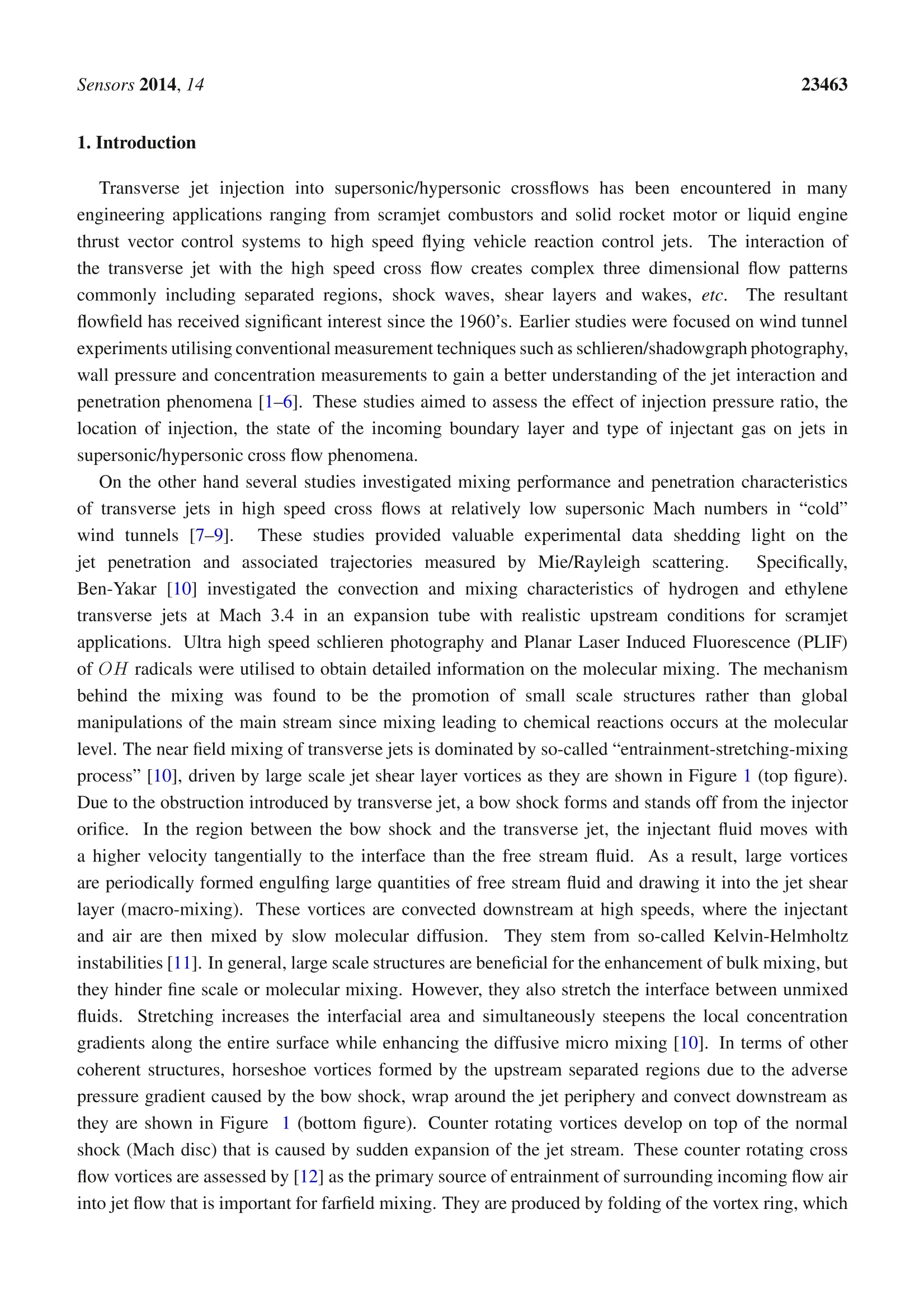
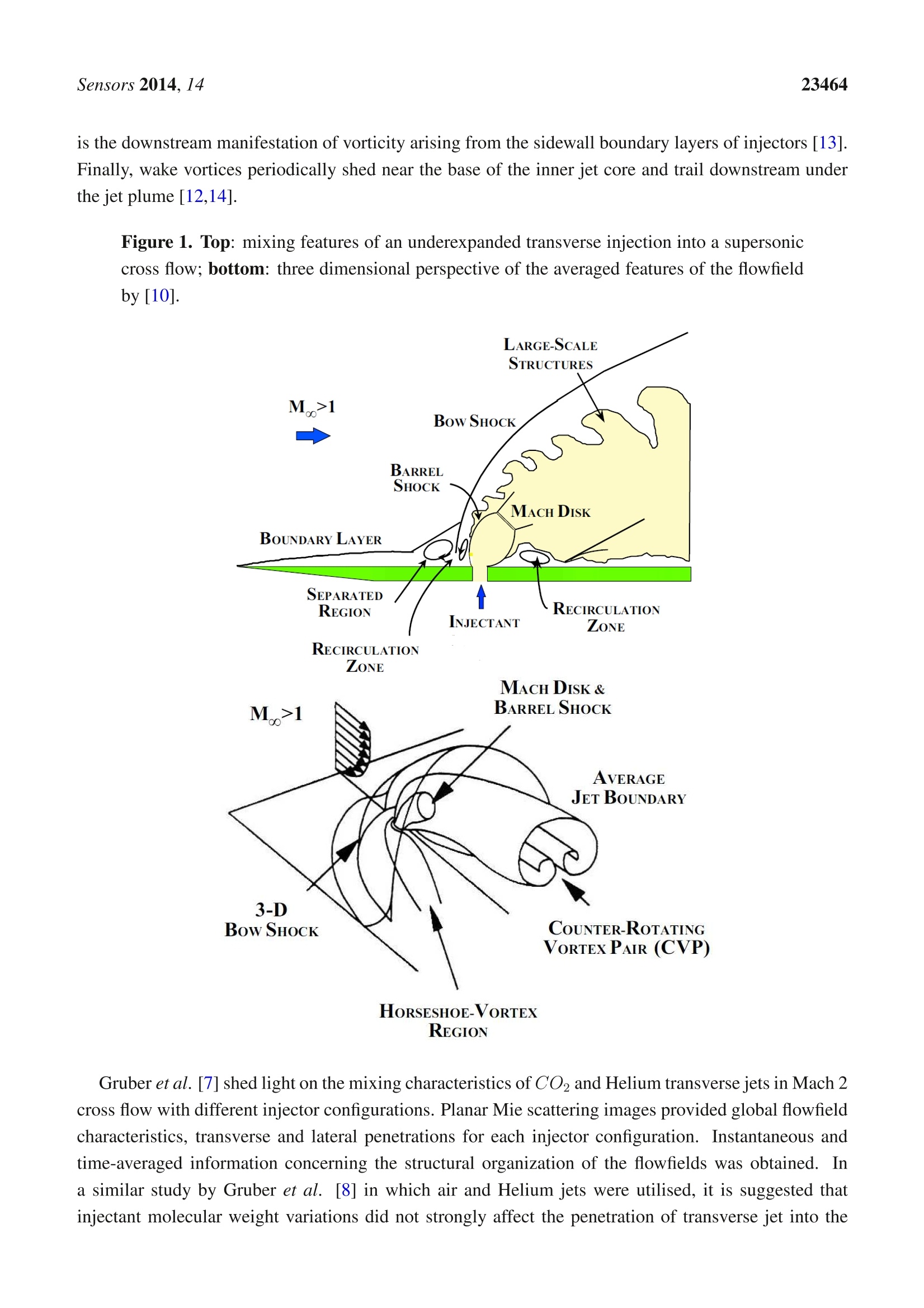
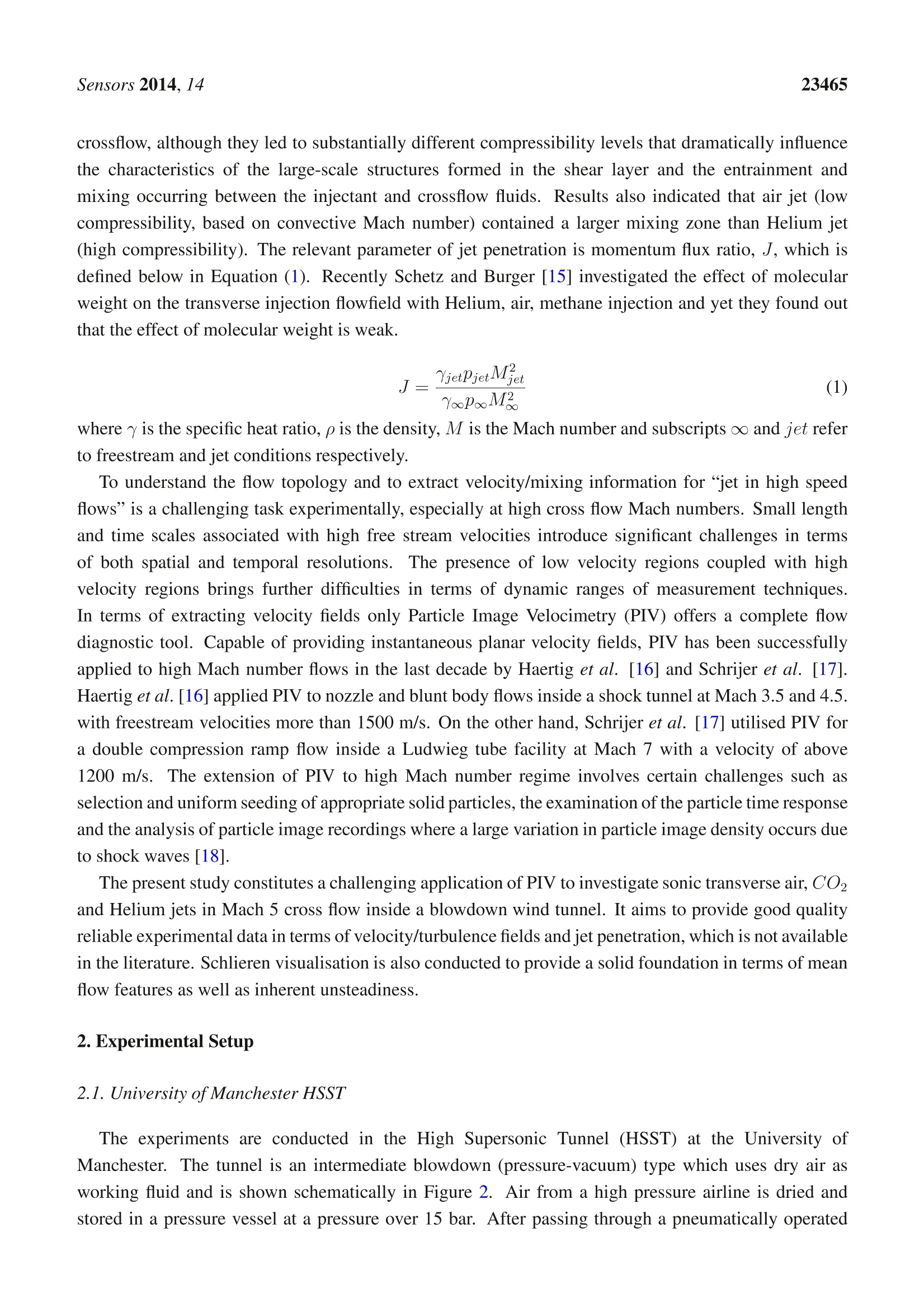

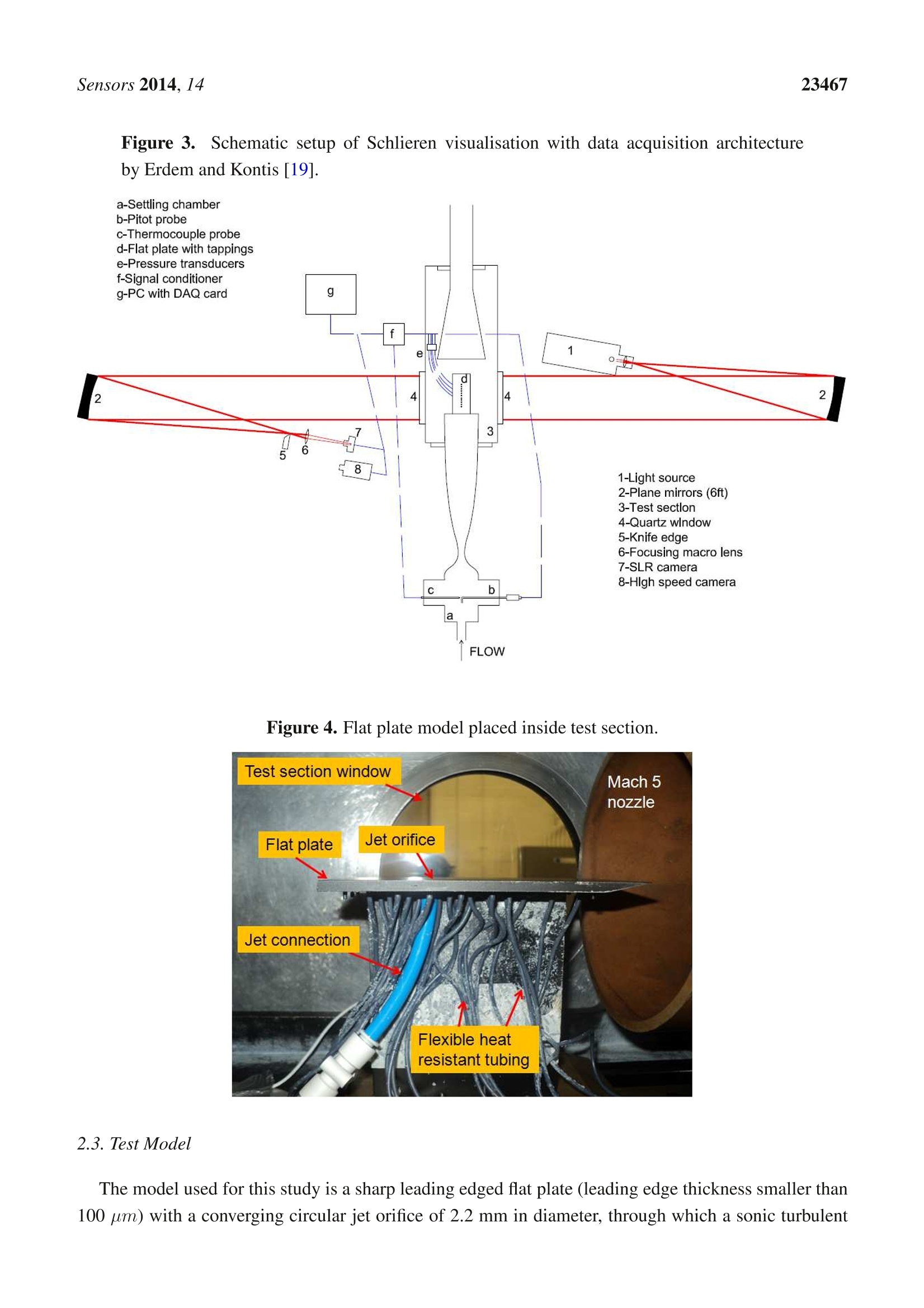
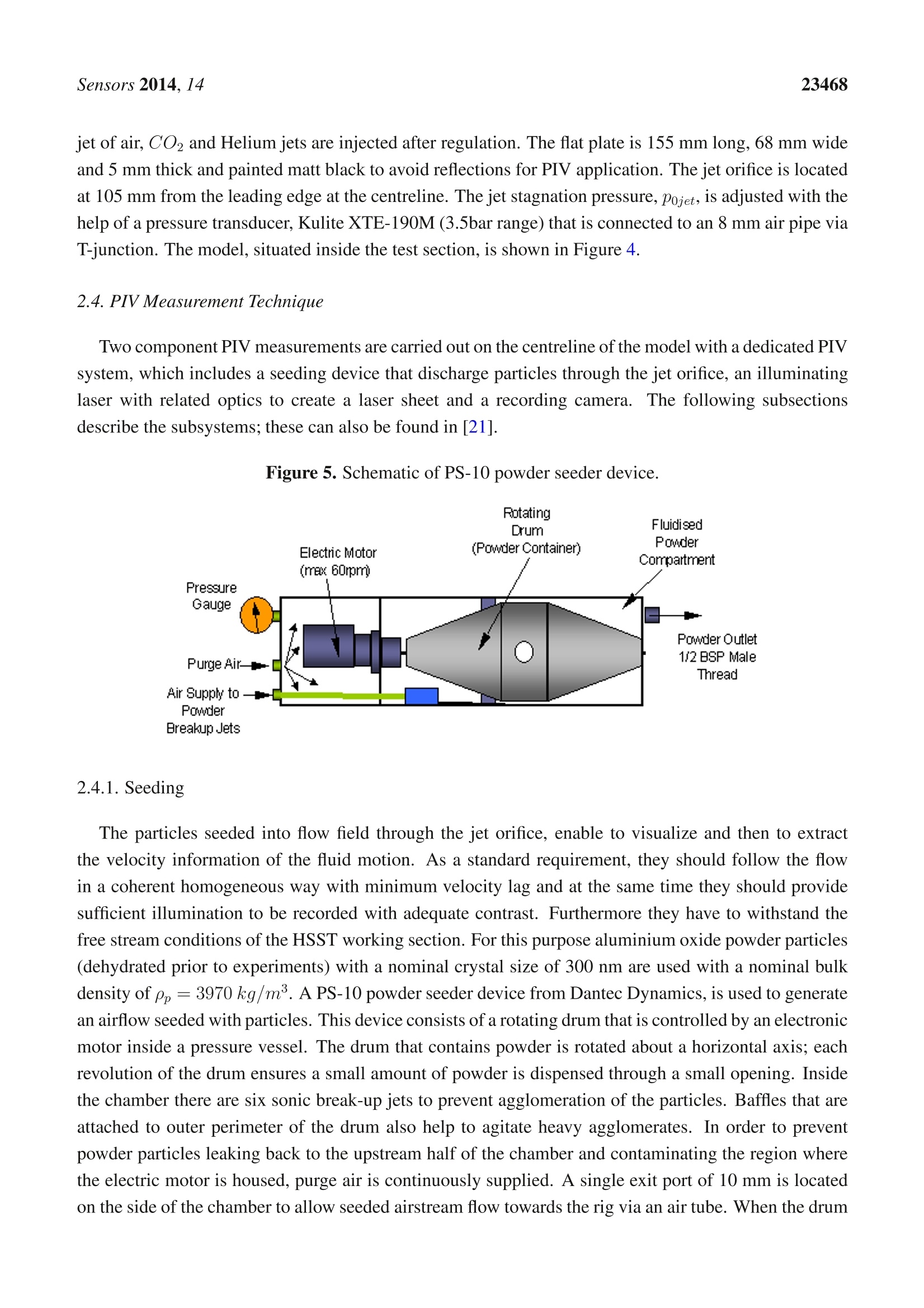
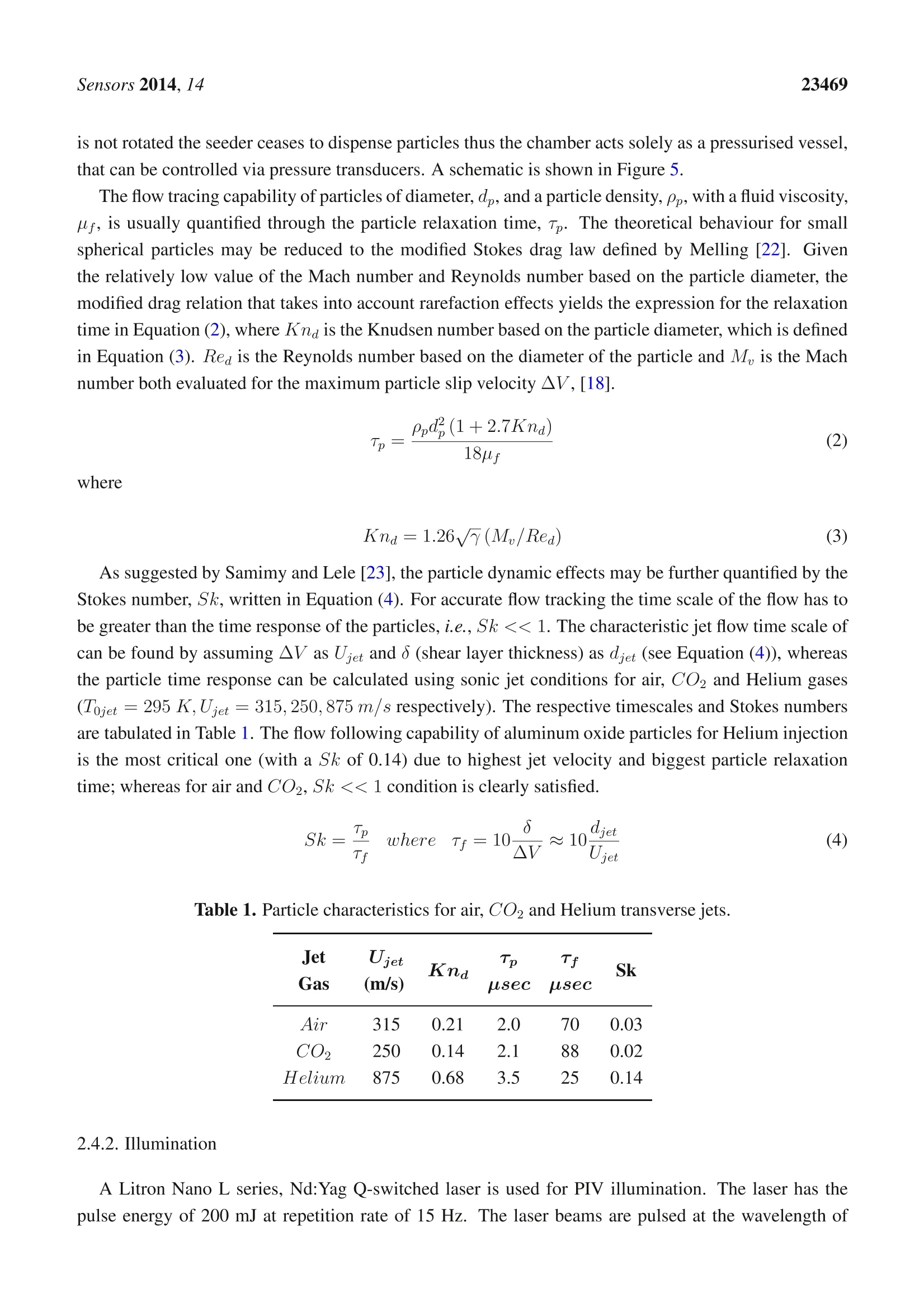
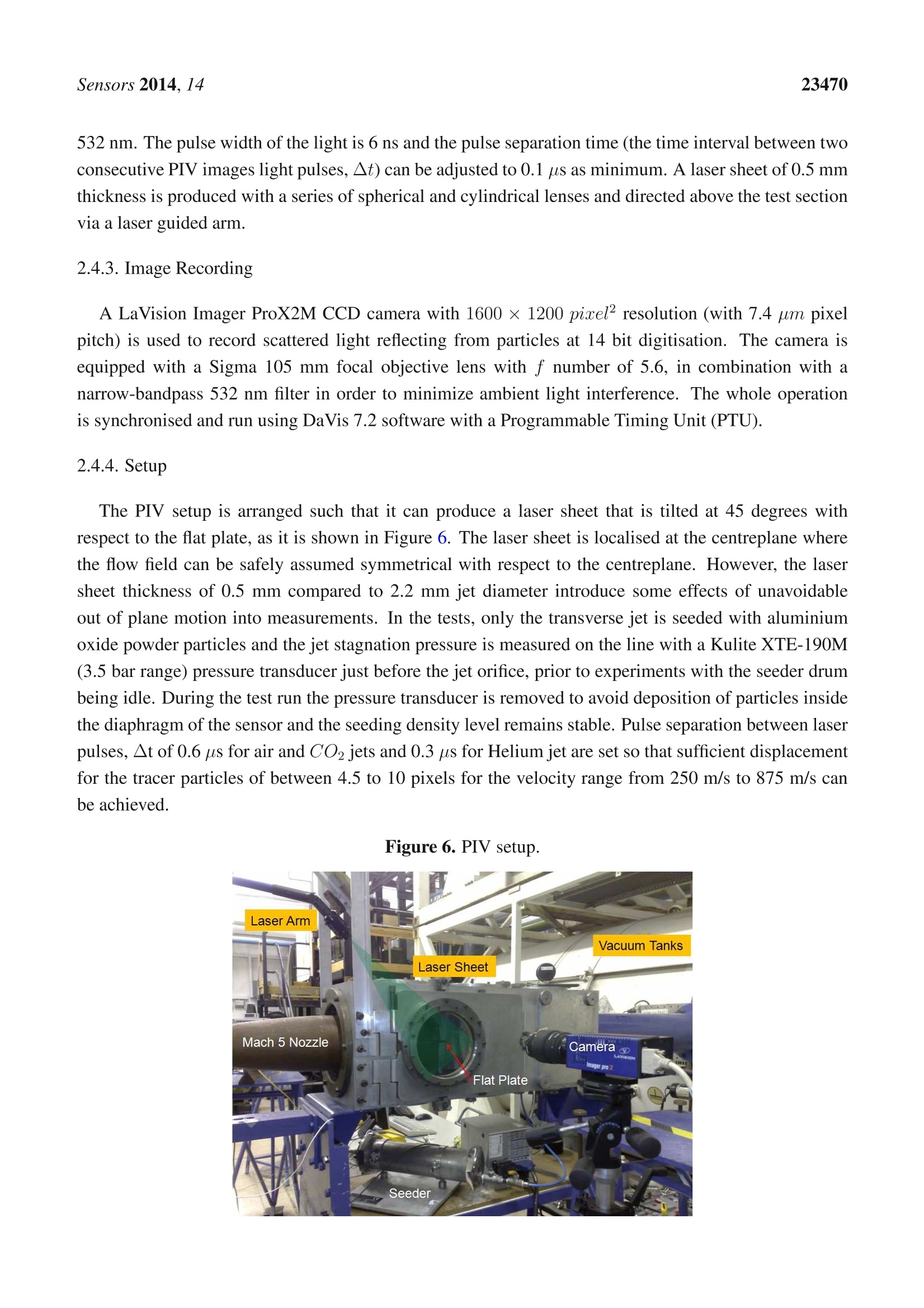
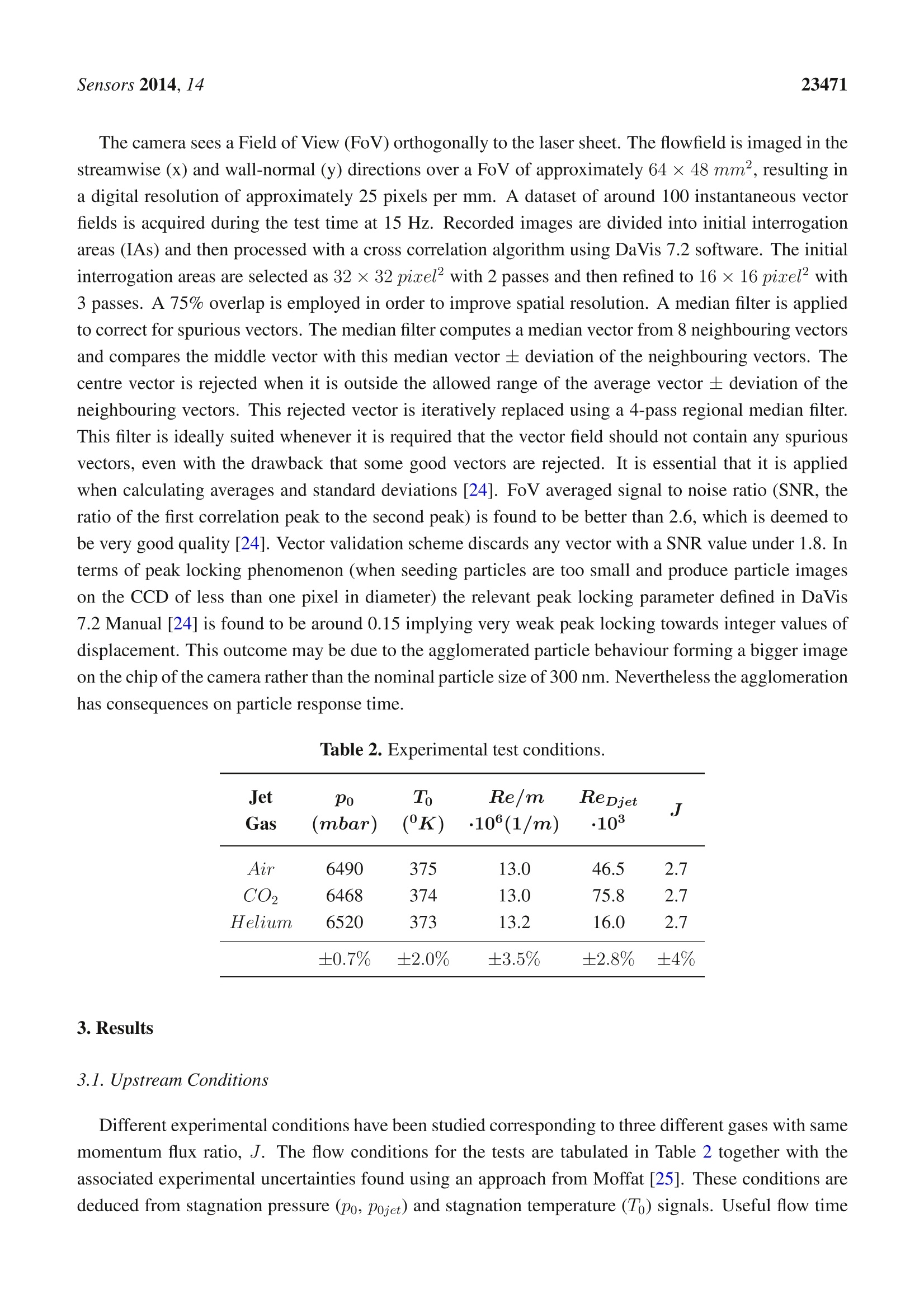

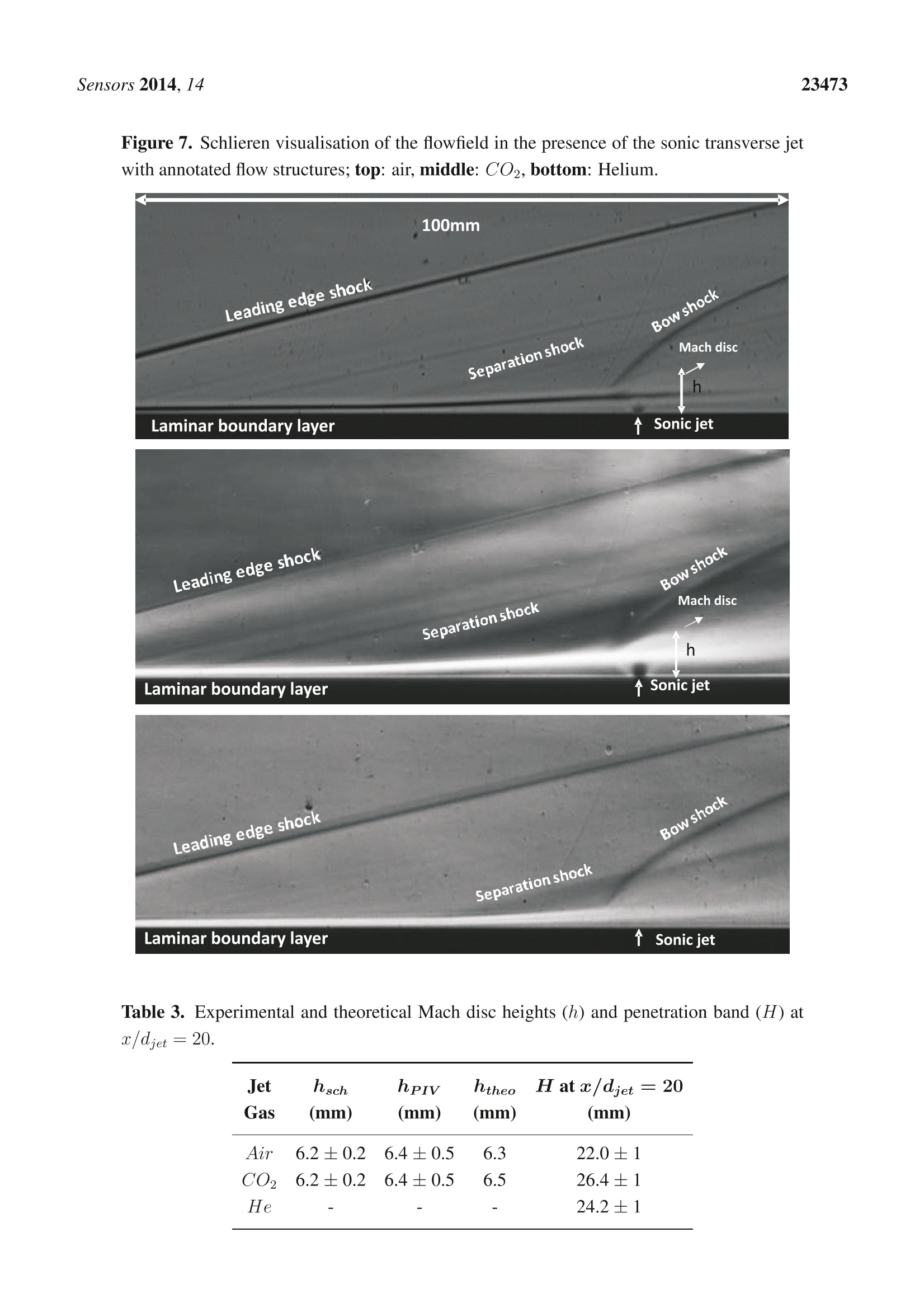
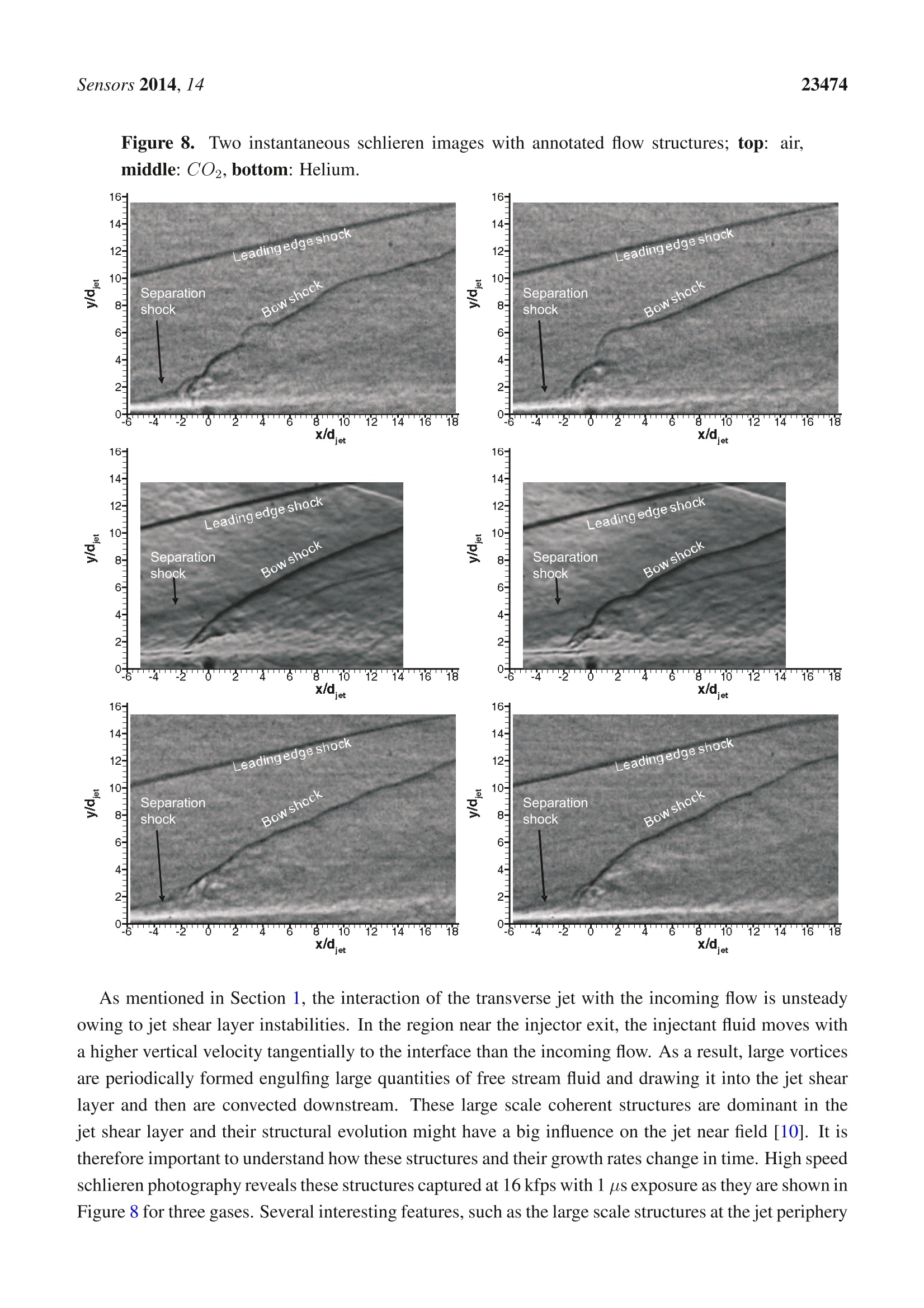
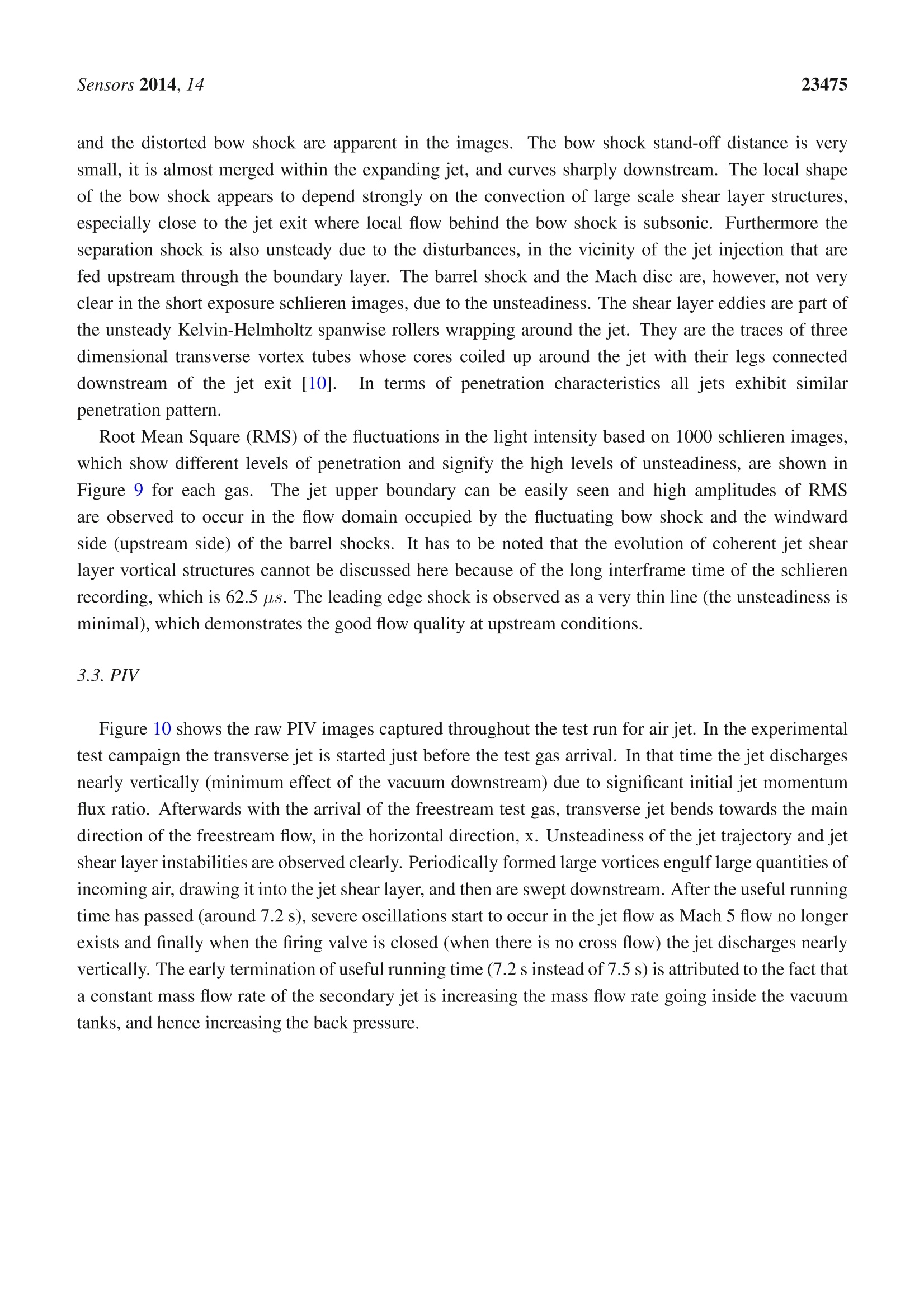

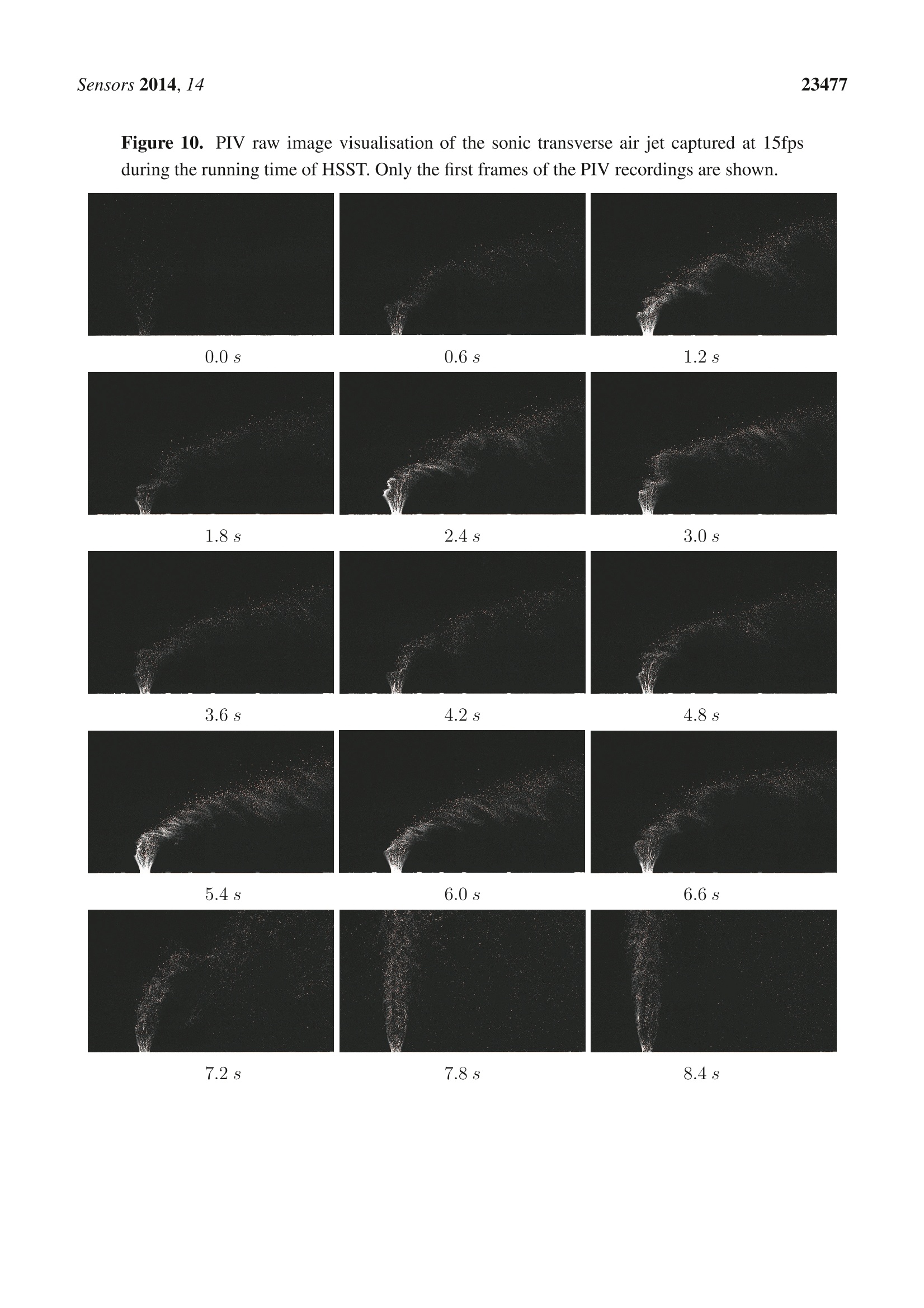
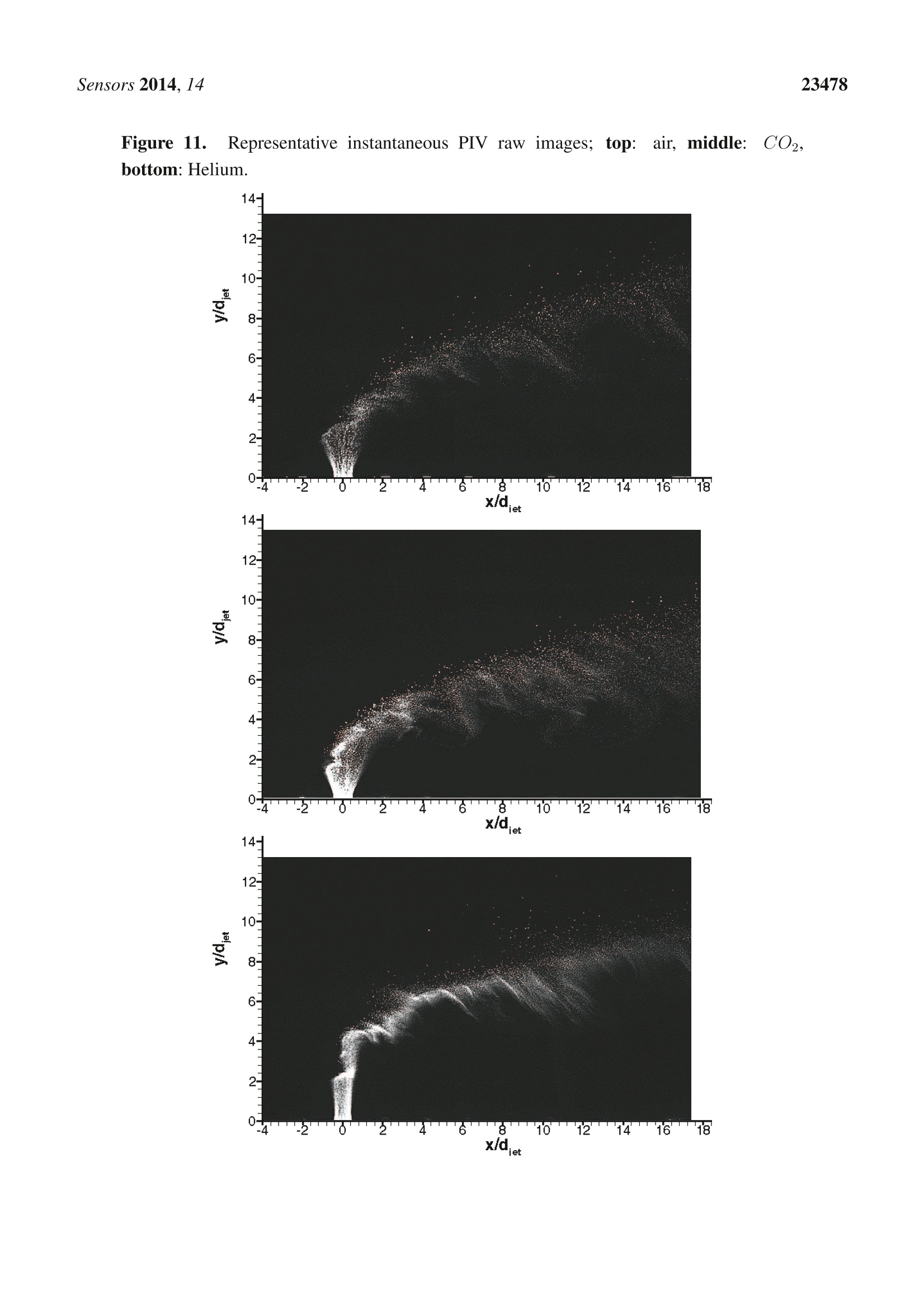
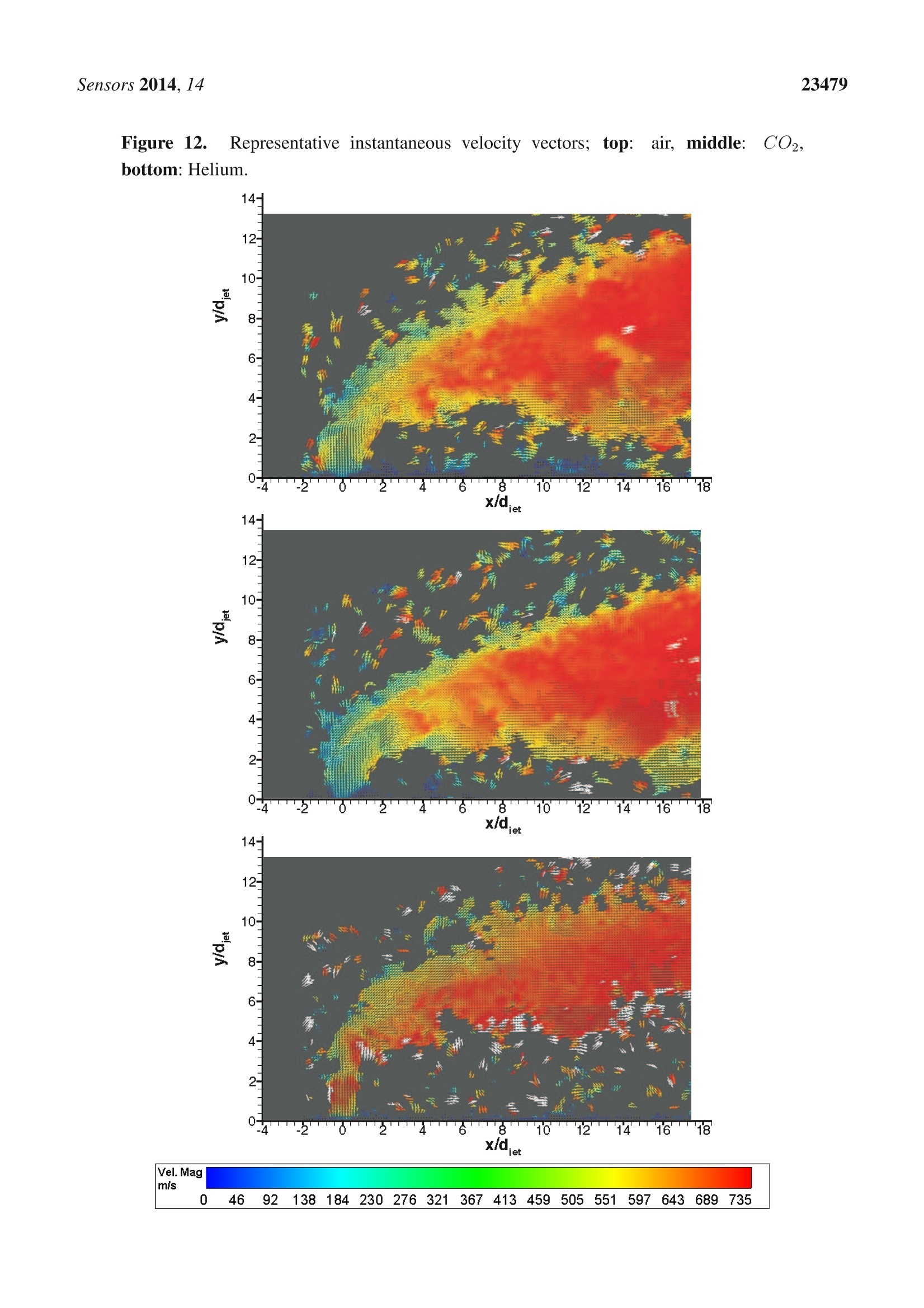

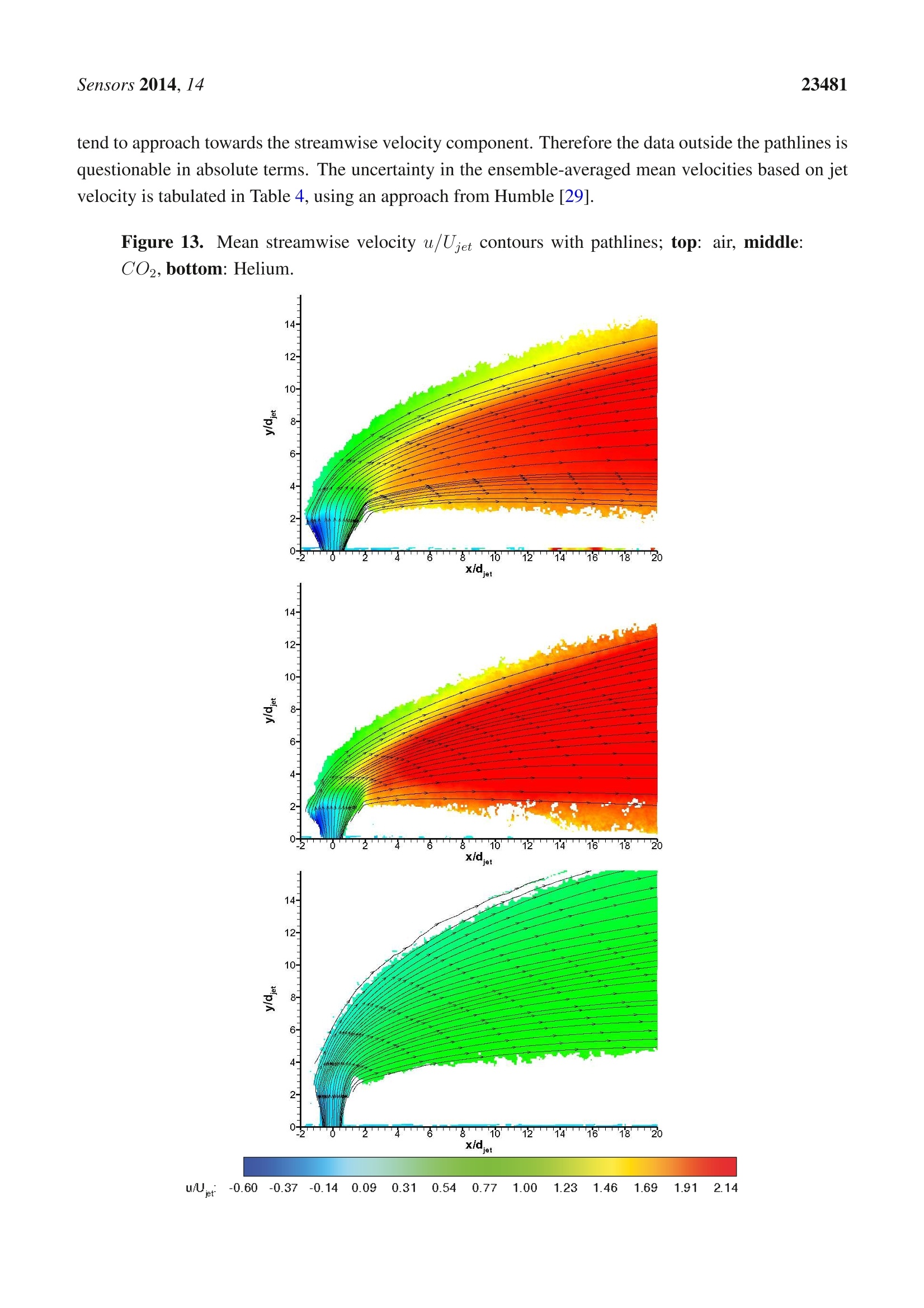
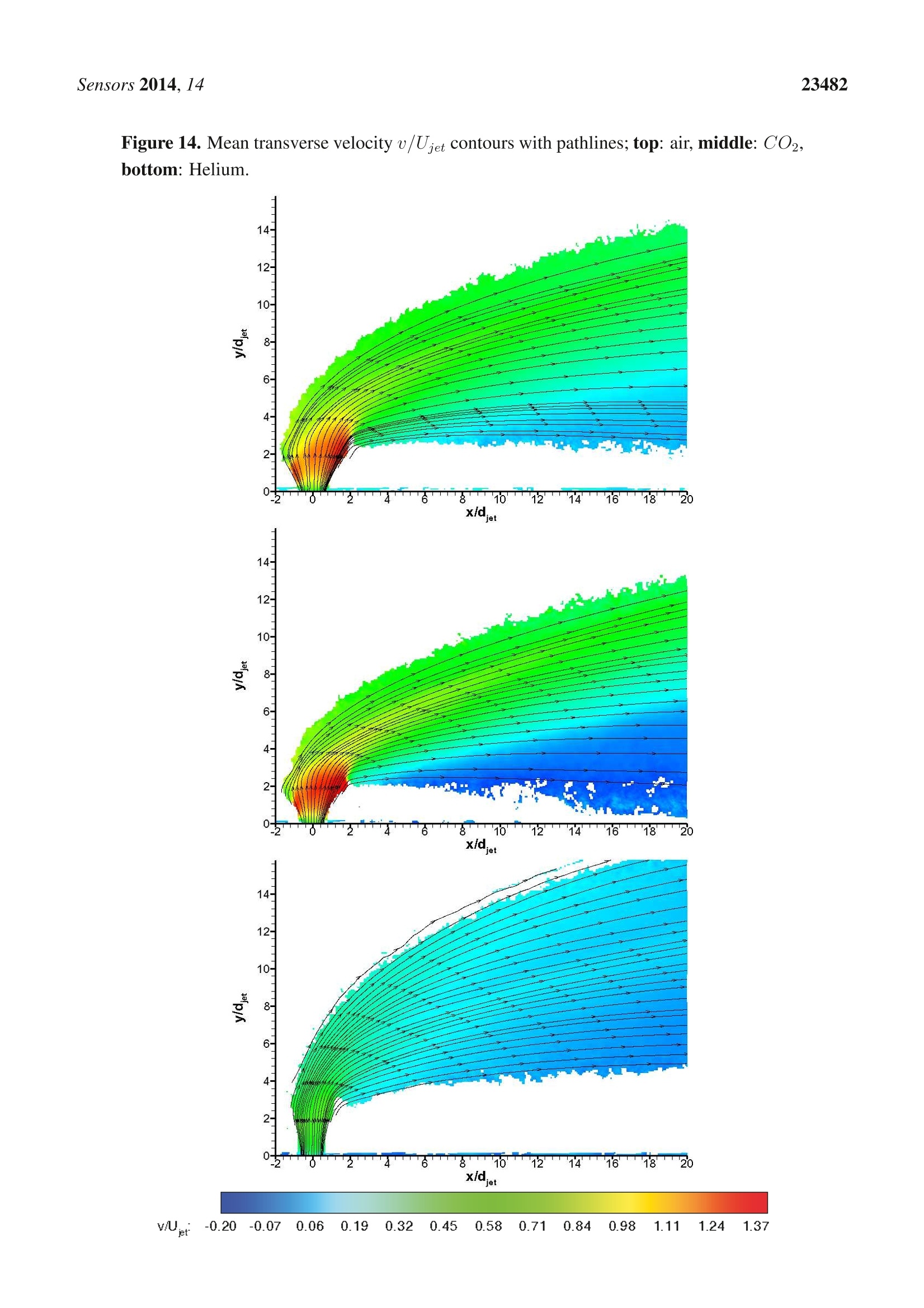

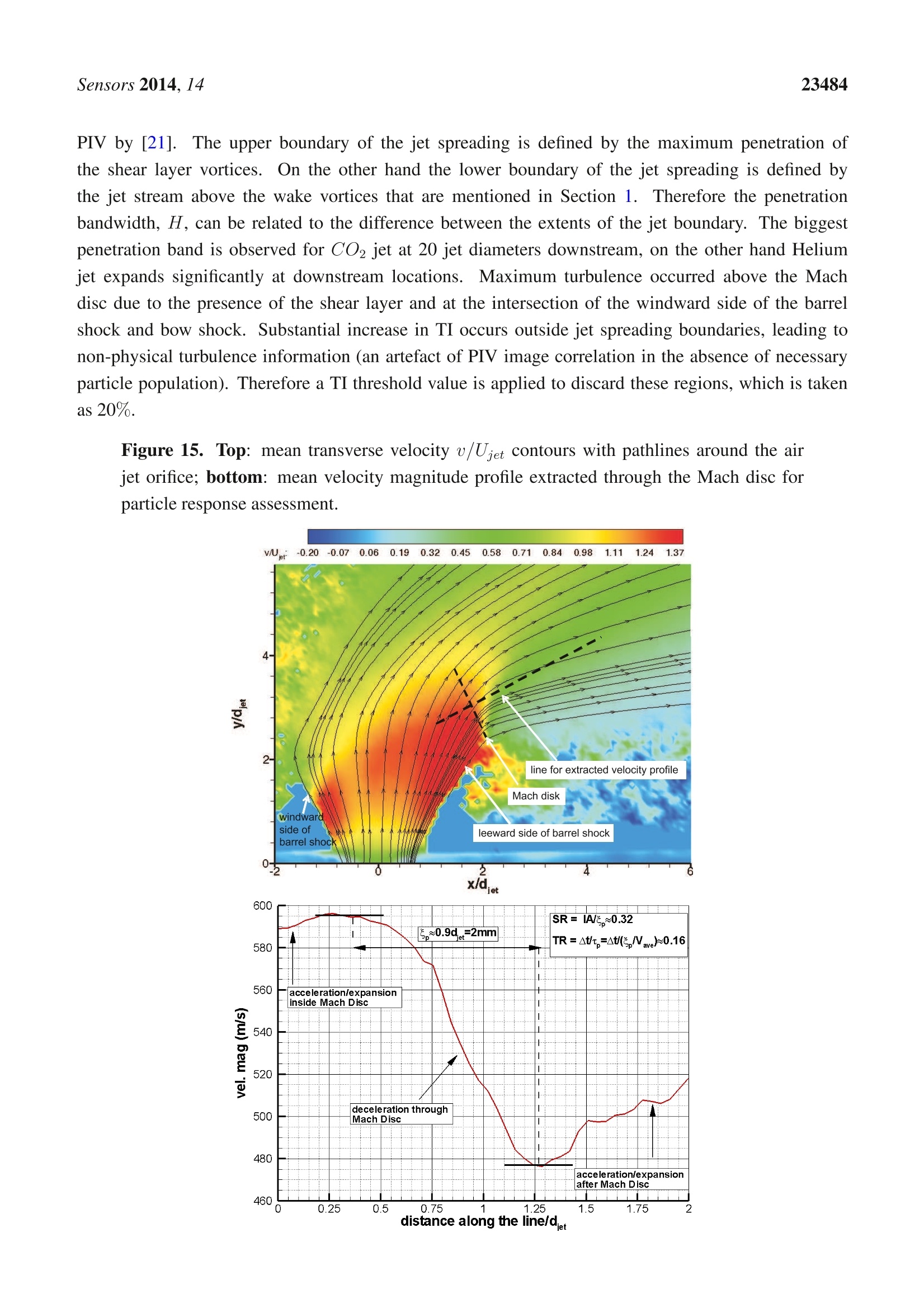

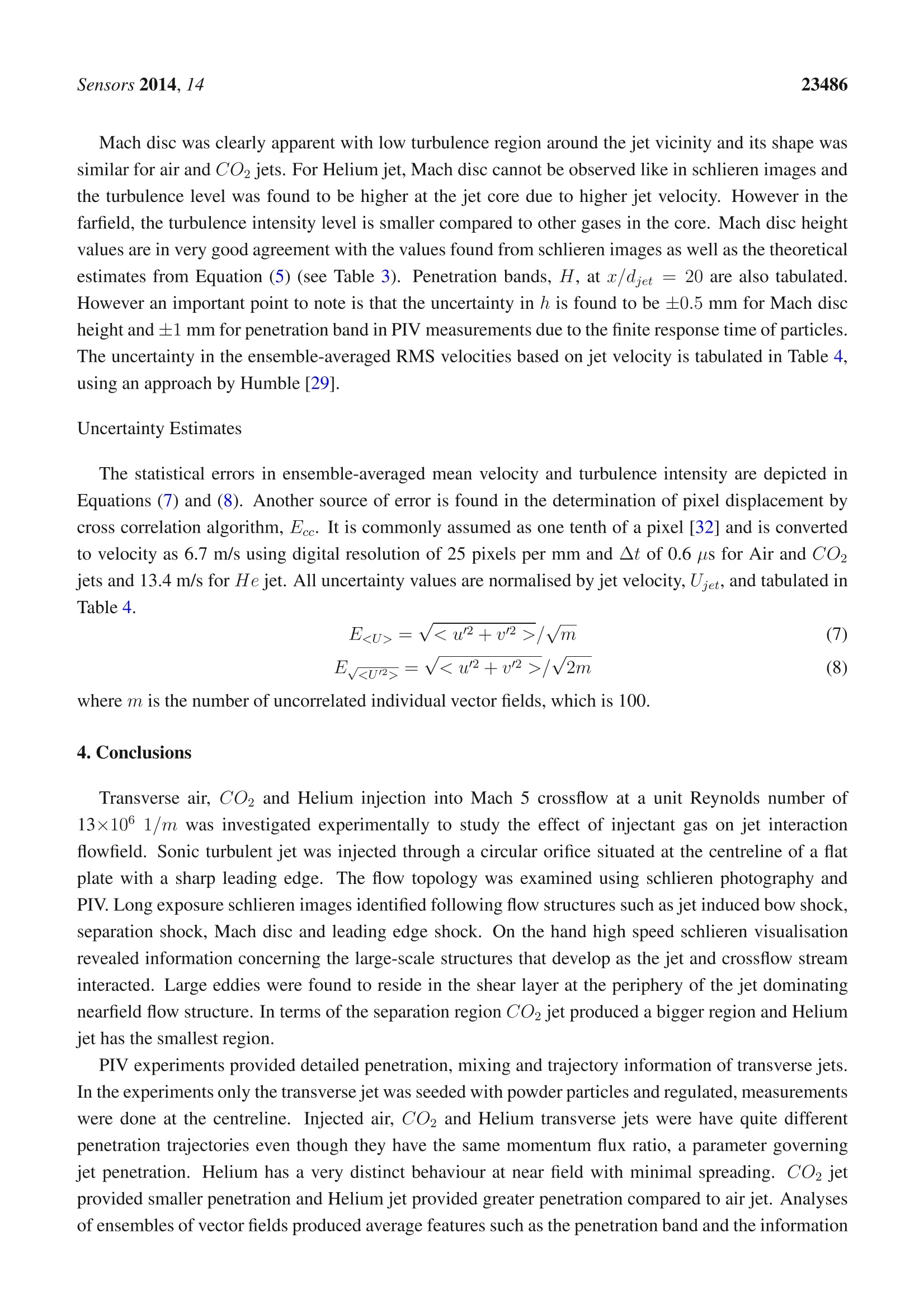
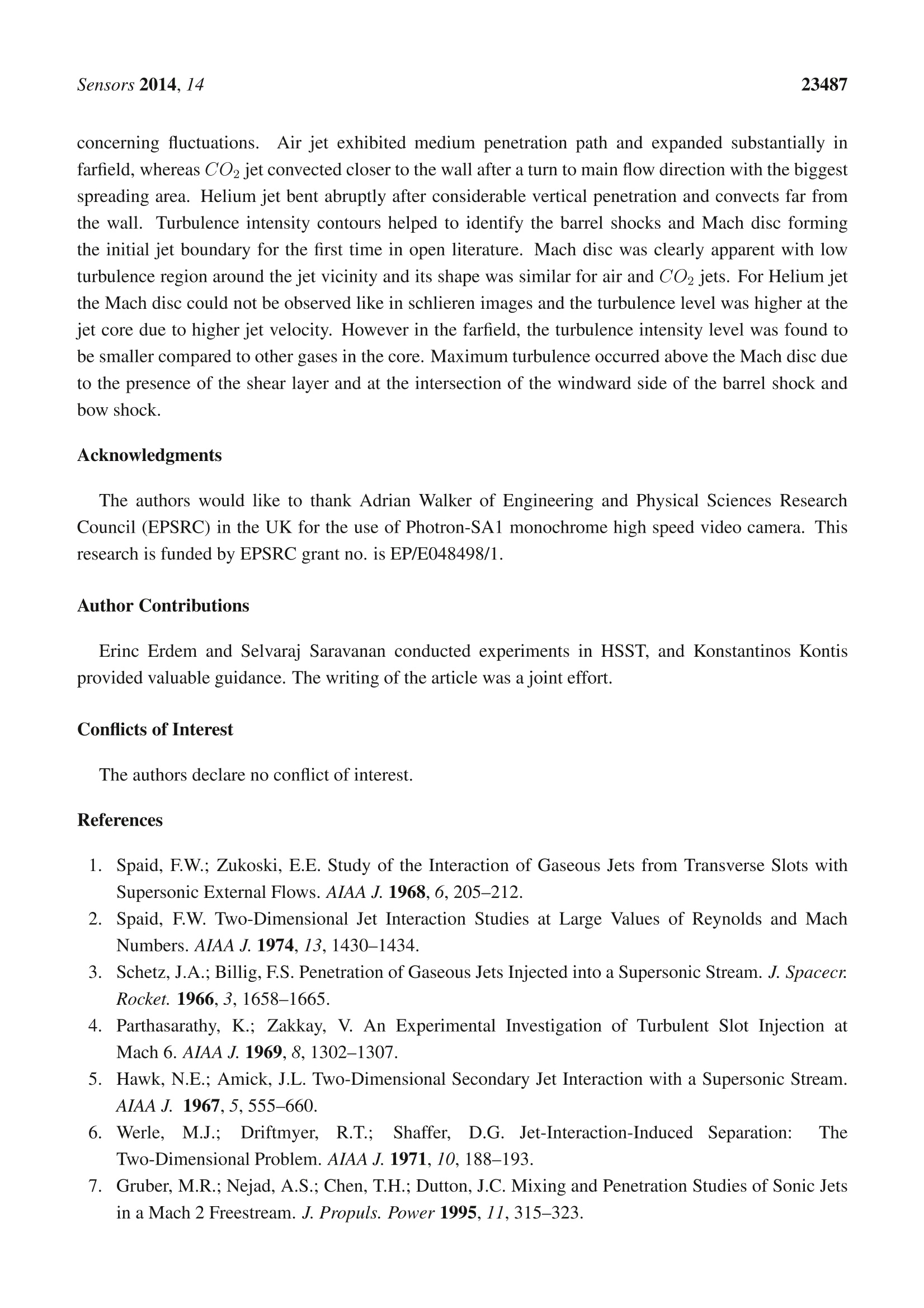
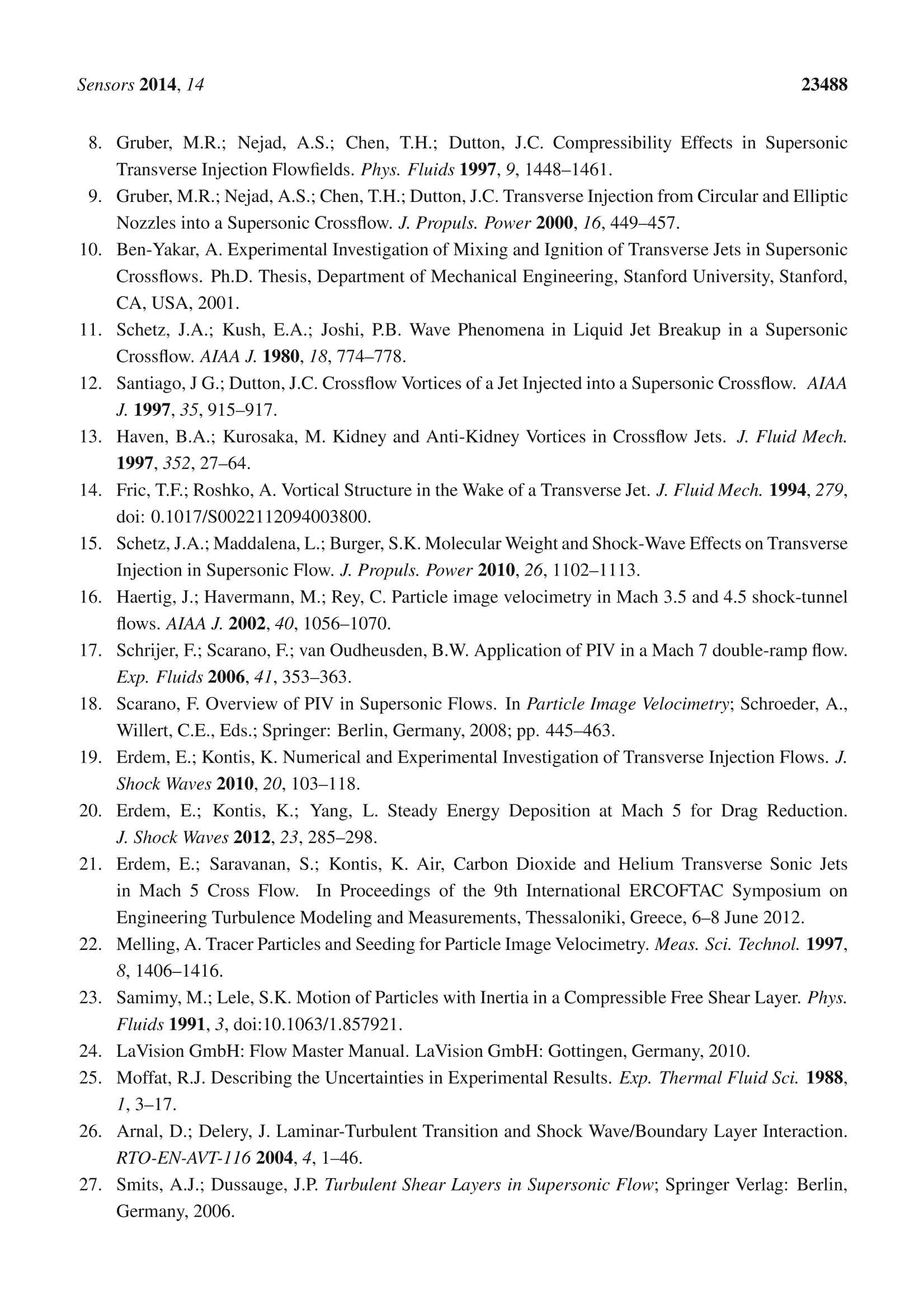

还剩26页未读,是否继续阅读?
北京欧兰科技发展有限公司为您提供《空气,二氧化碳和氦气交叉流体中速度场检测方案(粒子图像测速)》,该方案主要用于其他中速度场检测,参考标准--,《空气,二氧化碳和氦气交叉流体中速度场检测方案(粒子图像测速)》用到的仪器有德国LaVision PIV/PLIF粒子成像测速场仪、PLIF平面激光诱导荧光火焰燃烧检测系统
推荐专场
相关方案
更多
该厂商其他方案
更多

















